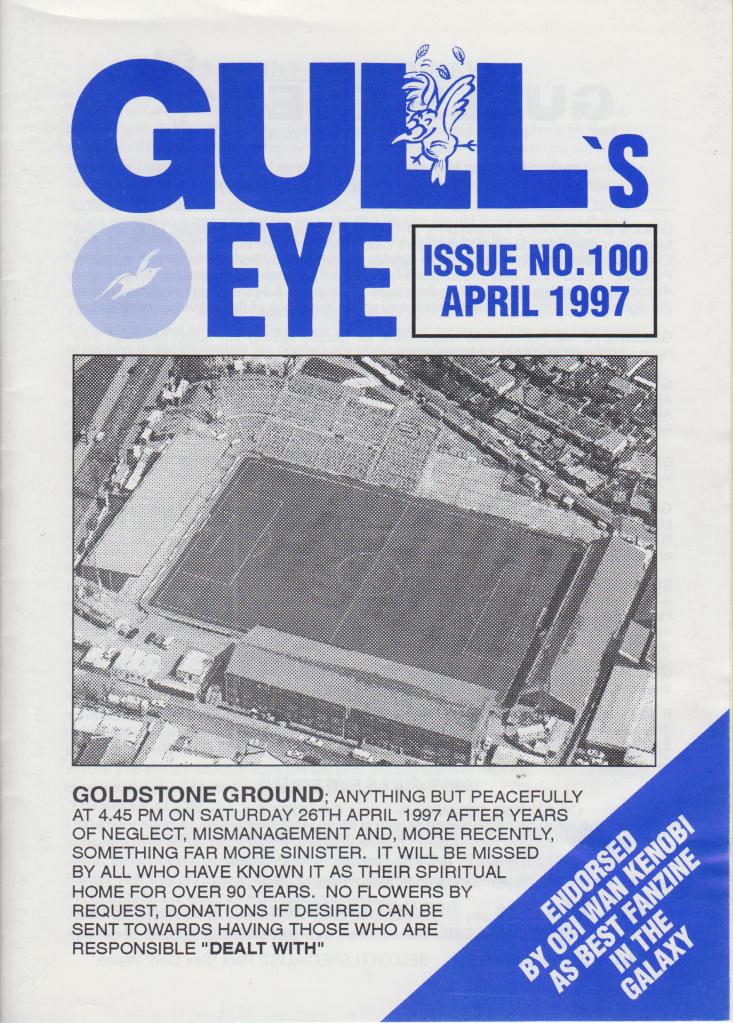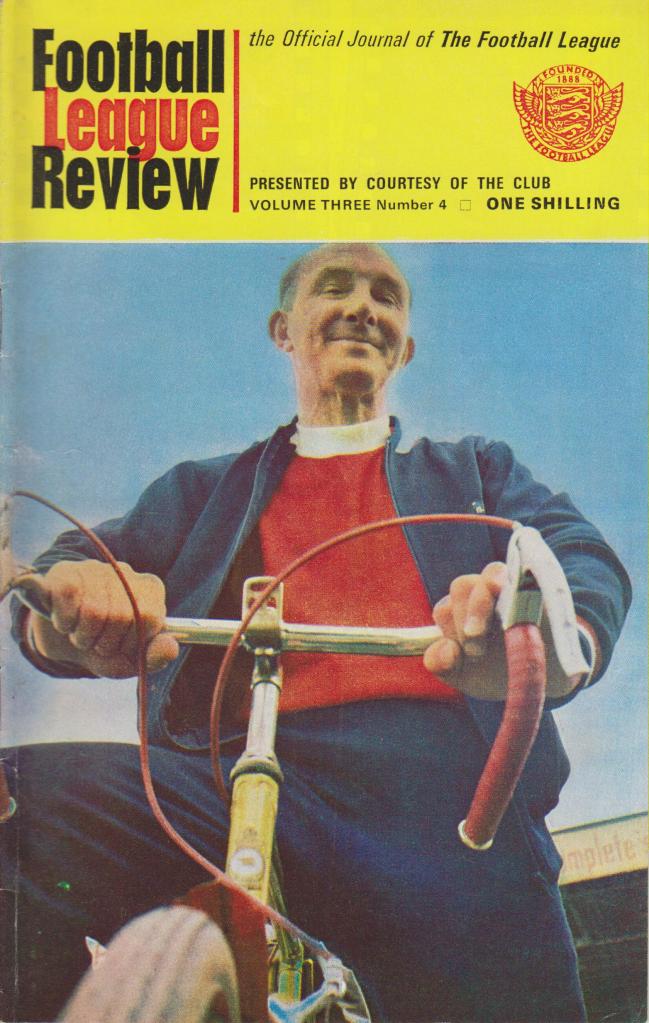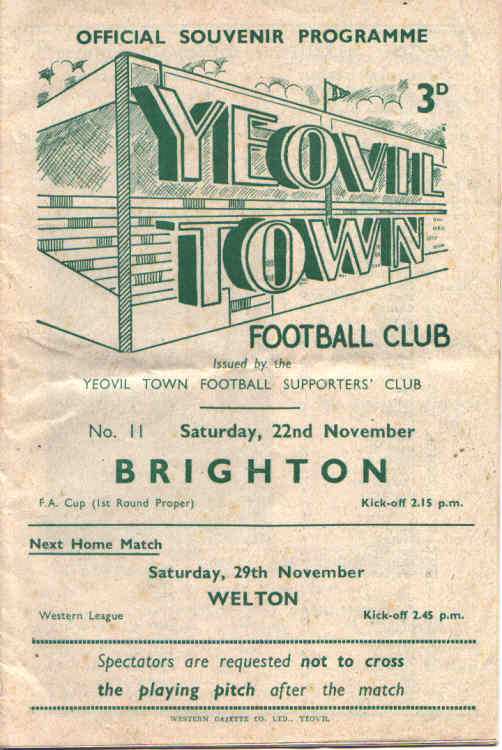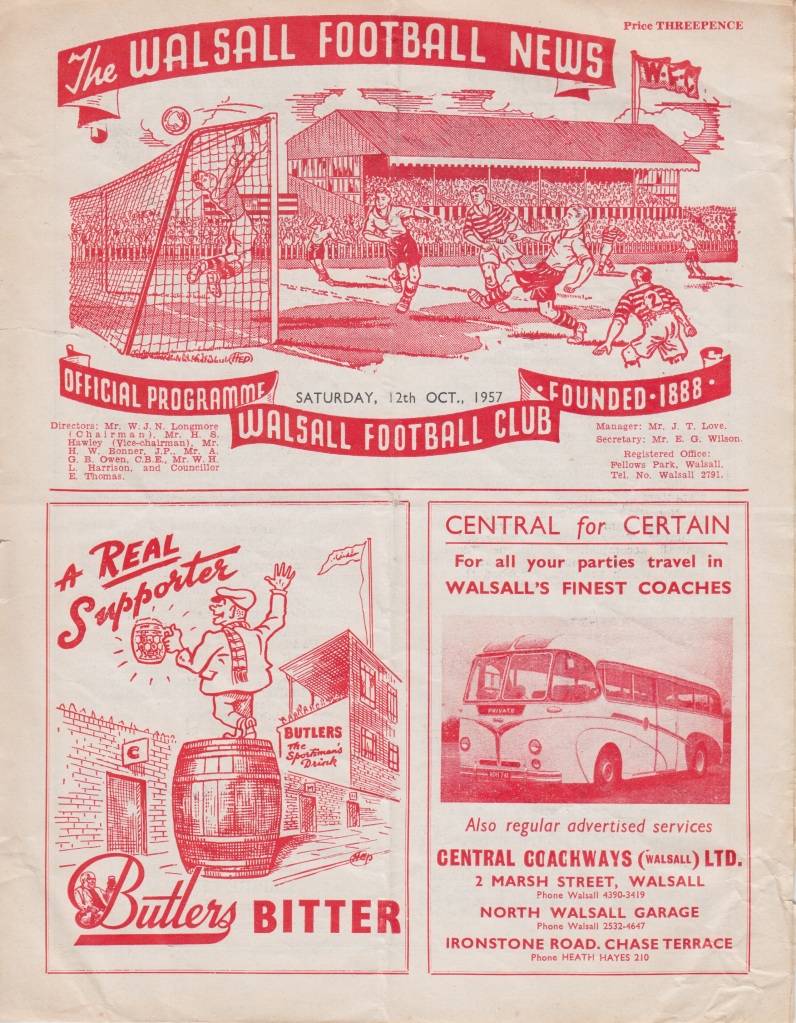Scanning – Completed it mate!
Back in 2009, I had the crazy idea to digitise my Albion programme collection and then host the images on a website. Here we are, 13 years later, and I think I’ve completed it all.
Or have I?
My website, http://www.seagullsprogrammes.co.uk has nearly 60,000 individual page scans covering my collection of programmes, fanzines and handbooks dating back to 1948. In addition, thanks to the help of other Albion collectors, I have also been able to share images of many pre-war and rare programmes. I recently finished scanning the programme from Albion’s game against Leicester City on 4th September this year. I can’t put this on the website until the end of the season (they are still selling them in the club shop) but it marked the completion of the scanning of all the home programmes I possess.
The site doesn’t just include programmes. I also spent the weekend scanning a number of fanzines sent to me by fellow Albion fan Marcus Hancocks, plugging some gaps in my collection. He sent me copies of ‘And Smith Must Score’, ‘Build a Bonfire’ and ‘Scars & Stripes’. It took me longer than usual to scan them, simply because I spent so much time reading them, as they took me on a nostalgic journey back to the Goldstone days and (in the case of Build a Bonfire) to the miserable time we spent ground-sharing with Gillingham.
These magazines are such an important part of fan culture in general but for Brighton & Hove Albion, they can lay claim to being major contributors to saving the club in the late 1990s. Publications such as ‘Gulls Eye’, free from the constraints of the official programme, were able to give vent to the fury felt by fans at the activities of the board of directors, specifically Messrs Archer & Bellotti.
As you can probably tell, I love fanzines and I’m so pleased that I’ve been able to share so many of them on the website. Another section of the site covers a magazine that was launched in August 1965 and which lasted for 9 years before disappearing. Starting life as ‘Soccer Review’, the magazine changed name twice, first to ‘Football League Review’ in 1966, then to ‘League Football’ in 1972. The 366 issues of the magazine are jam-packed with news, information and features on the Football League, and formed a huge part of my football education as a child growing up in the 1960s and 70s. I am happy that I have scans of every page of every issue but be careful. Dip into that section of the website at your peril, you will lose yourself in 60s and 70s football nostalgia.
You would think at this stage that I would take a step back, put my feet up and just spent my time on twitter, sharing programme covers from ‘on this day’ in Albion history.
Not a chance
Scanning is a pain in the arse. You have to align each page, set the borders and then constantly check each time you turn the page, that everything is still in place. I then have to number each image and when each programme is done, upload it then edit the website to make sure all the links work. I should be glad that I’ve ‘finished’ it all. But I’m not. I want to do more.
Away programmes seems the obvious place to start. I’ve got around 1,250 away programmes dating back to the immediate post-war period and as with all programmes, they represent a unique snapshot of that particular club at a particular moment in history. The only thing holding me back is whether Albion fans are interested in reading, for example, Neil Warnock’s programme notes, or the statistics around the season so far for Barnsley in 1984/85.
We will see.
I’ll start with the old stuff. For me, the 16-page programmes from the 1950s are way more interesting than some of the 100-pagers from the 2020s. Back then, the programme was full of news from the club written by people within the club, as well as adverts for local fishmongers, newsagents and haberdashers. No sign of the syndicated articles and adverts for MacDonalds, Snickers and Nike.
And look at the covers. They are magnificent. Take this one from Walsall from 1957. A superb drawing plus adverts from two companies local to the club. Inside there’s even more fantastic content so yes, away programmes it is!
In the words of Jimmy Cricket, “There’s More!”.
My collection doesn’t just include programmes, fanzines and handbooks. I recently found a box full of old newspapers, mostly Brighton Argus specials covering things like the 1979 promotion parade, The 1983 FA Cup Final (obviously) and equally obviously, the last days of The Goldstone. So I’ll be dusting off the A3 scanner to share these with you over the coming months as well.
Please excuse me, I’ve got some scanning to do!
I’ll leave you with the front cover of one of these newspapers.
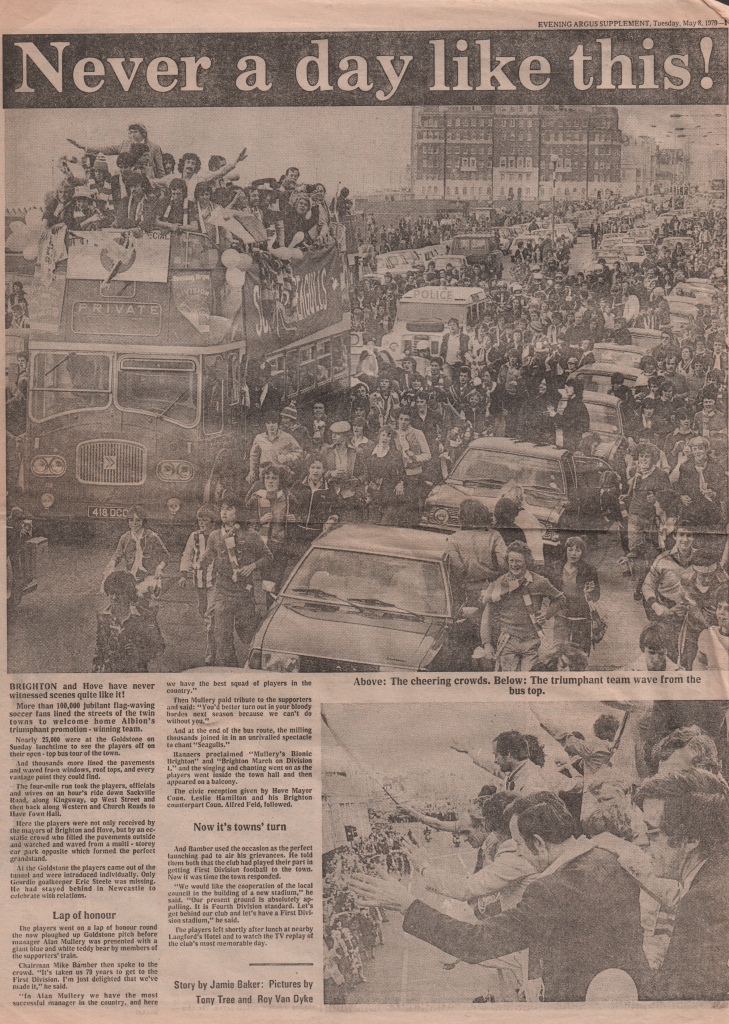
My Football Programme Obsession
As I write, we are three months into the lockdown imposed as a result of the Coronavirus outbreak. It seems to have slipped into our everyday lives and although Premier League football is coming back next week, a return to what we previously thought as ‘normal’ seems a LONG way off.
Different people have taken different things from this enforced period of inactivity. I manage a local Village Hall and after we were forced to close, I realised that this was a fantastic opportunity to sort out my programme collection. Using the hall meant I could spread things out and, more importantly, leave it all out overnight. My amazing (and incredibly understanding) wife tolerates my programme collection but has drawn the line at my suggestion that we wallpaper the walls with a collage of old Brighton programmes.
So how did this all start?
Like most young kids growing up in the 1960s, collecting things was an important part of my childhood. Most of my mates at School had their bags stuffed with all manor of random stuff, all lovingly collected. I dabbled with all sorts of things. Stamps came and went, as did bus tickets and the various collector cards that came with a little stick of bubblegum. Nowadays of course, these things would be worth a few quid but at the time, as I moved onto the next big thing, I just threw them out.
As the 60s drew on, football had become my all-consuming passion and it was natural that my collecting focus would have something to do with the beautiful game. I became fascinated by the different styles, sizes and designs of football programmes. In the 1950s and 60s, as post-war austerity gave way to a more plentiful supply of raw materials, the programme grew from something little more than a teamsheet, into a more substantial offering.
They were a million miles away from the 100-page monsters we see today, but for a young boy obsessed with football, the programmes I collected provided a window to a world that was largely inaccessible. This was 30 years before the internet became available to the masses and bar the odd glance at my parents’ newspaper, I had little contact with the football world.
My Dad passed away last year after a long battle with the effects of Dementia. One of my fondest memories of him (I have quite a few so there is a lot of competition) is my very first ‘live’ game of proper football. Dad was a PE Lecturer at a teacher training college so sport was a huge part of our lives. I spent every Saturday on the playing fields, watching the Bognor College of Education football team doing battle in the West Sussex League Premier Division.
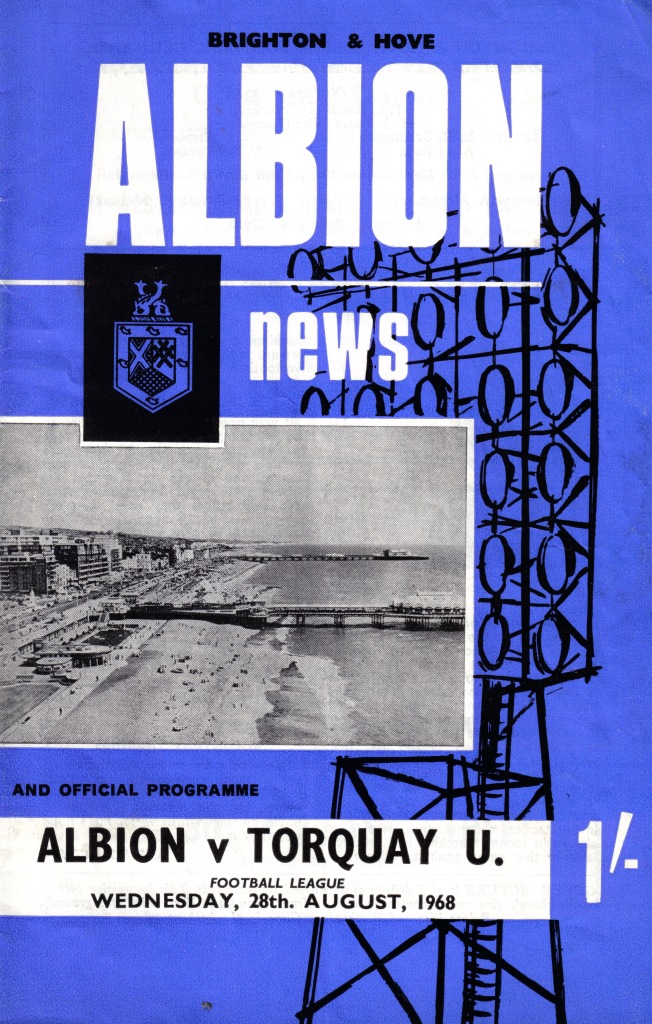
My Godfather’s brother played for Torquay United and on August 28th 1968, they were playing Brighton and Hove Albion at The Goldstone Ground in Hove. My Dad and Godfather took me to the game for my 9th birthday, which had been the day before. The programme from that match is one of my most treasured possessions and the game also marked the start of my lifelong love affair with the Seagulls, a relationship that was to shape my collecting habits in the years to come.
The proliferation of football magazines in the late 1960s provided much of the information about the wider football world that I craved. Charles Buchan’s Football Monthly, Shoot!, Scorcher & Score, Goal! and many others, were an absolute goldmine for me, desperate for information on the game that I loved. These magazines also helped me fuel my growing passion for programmes. I couldn’t get enough of these small pamphlets of joy, snapshots of life at a football club. The classified pages in the magazines devoted huge amounts of space to the hobby.
I have a copy of Charles Buchan’s Football Monthly that has no less that 26 separate adverts for programmes, as well as a double-page list of collectors wanting to swap their doubles.
“Can offer a large selection of Rochdale homes. Will swap for Man Utd aways or similar”
This reads like a grossly unfair trade but to the collector, this is the bread and butter of the hobby. There would be someone, somewhere, sitting on a pile of Rochdale programmes. The classified adverts provided a means by which the lad could trade his products of the Spotland programme shop for similar offerings from Old Trafford.
After poring over these offers, I made many trips to the Post Office in Bognor Regis High Street, to buy that essential item of currency, the Postal Order.
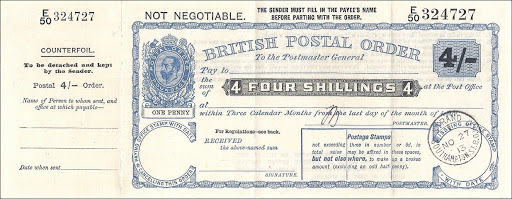
The Postal Order was the staple currency for the collector and along with the required stamped addressed envelope, this was the gateway to the hobby.
I started by buying lots of ‘bargain bundles’ and soon assembled a decent collection of programmes from Arsenal to York City. I quickly realised that some sort of specialisation was needed. It’s impossible to collect EVERY programme from EVERY club and apart from that, my pocket money would only stretch so far.
My first task was to collect at least one programme from every club in the football league. The bargain bundles helped but my task was only finished after lots of correspondence with clubs like Barrow and Southport.
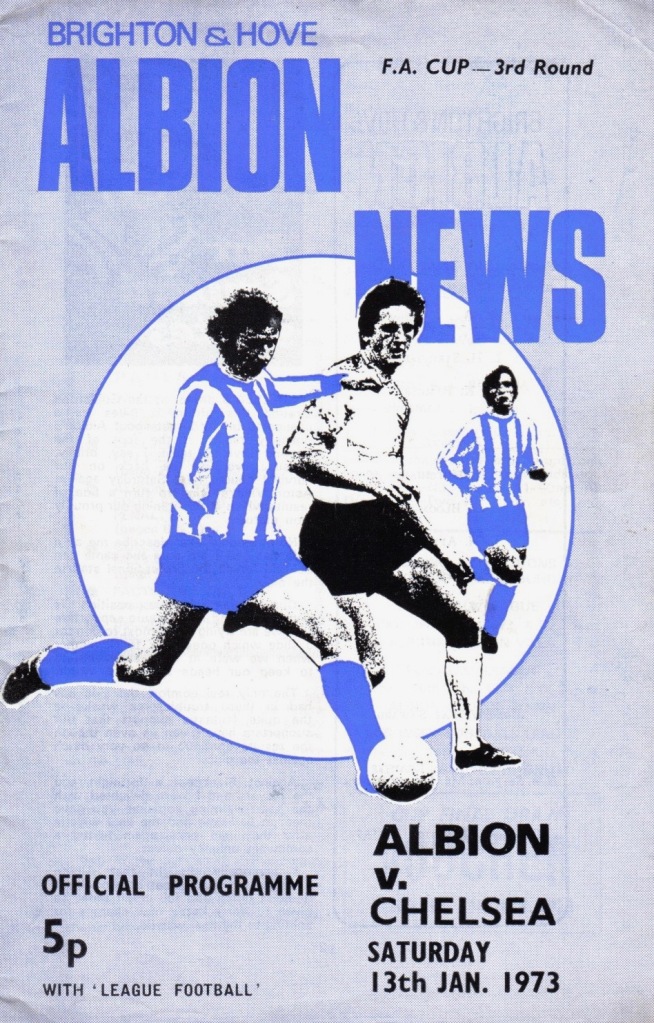
Into the 1970s and I started going to watch Brighton more regularly, travelling on the train from Bognor to Brighton (change at Barnham. Did I mention I also had a brief dalliance with trainspotting?). In 1972/73 we had a season in the (old) second division and a glamour FA Cup tie against Chelsea, but order was soon restored and Albion reverted to their role as ‘perennial third division also-rans’.
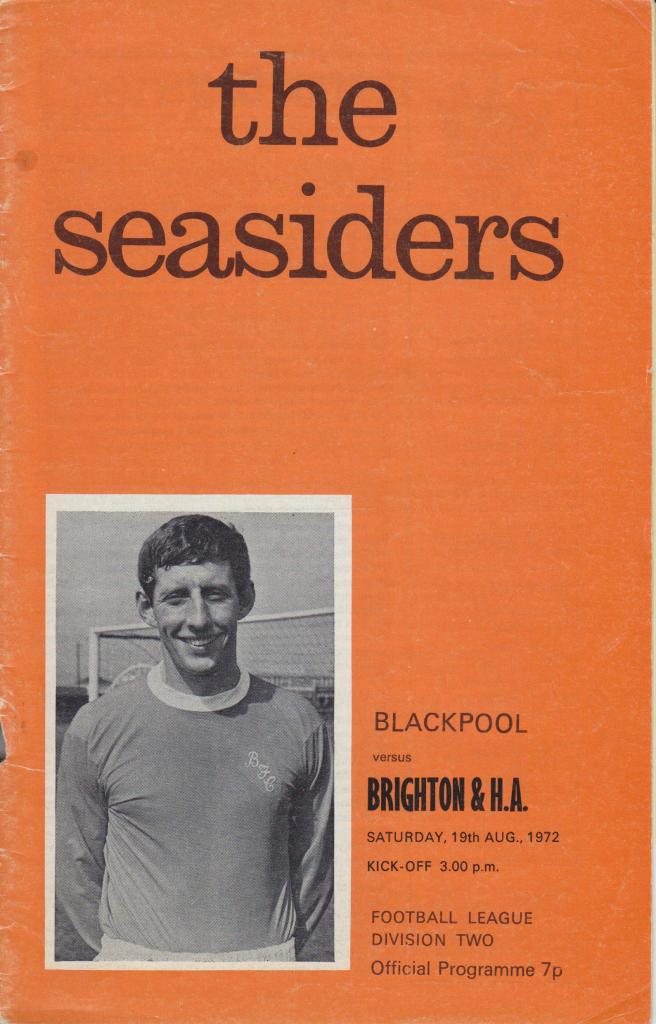
That wasn’t the only reason for my trips. In the north-west corner of the ground, nestling between the clanking turnstiles and the rancid stench of the hotdog stand, was the Albion Programme Hut. Like everything else at the Goldstone, the hut was a bit ramshackle but it was my Aladdin’s Cave, full of programmes from places like Blackpool, Carlisle and Rochdale. I was thirteen years old and this place was fantastic. I was desperate to get my hands on as many as possible, but always with the need to enhance my collection. Brighton programmes dominated the shelves and sensibly (but almost by accident) Albion became the dominant club in my collection.
The period from 1975 to 1980 was a golden era, both for Albion and me. Two promotions, Peter Ward and the arrival of first division football for the first time in our history, provided the backdrop. For the first time I could add Manchester United and Liverpool programmes to my collection.
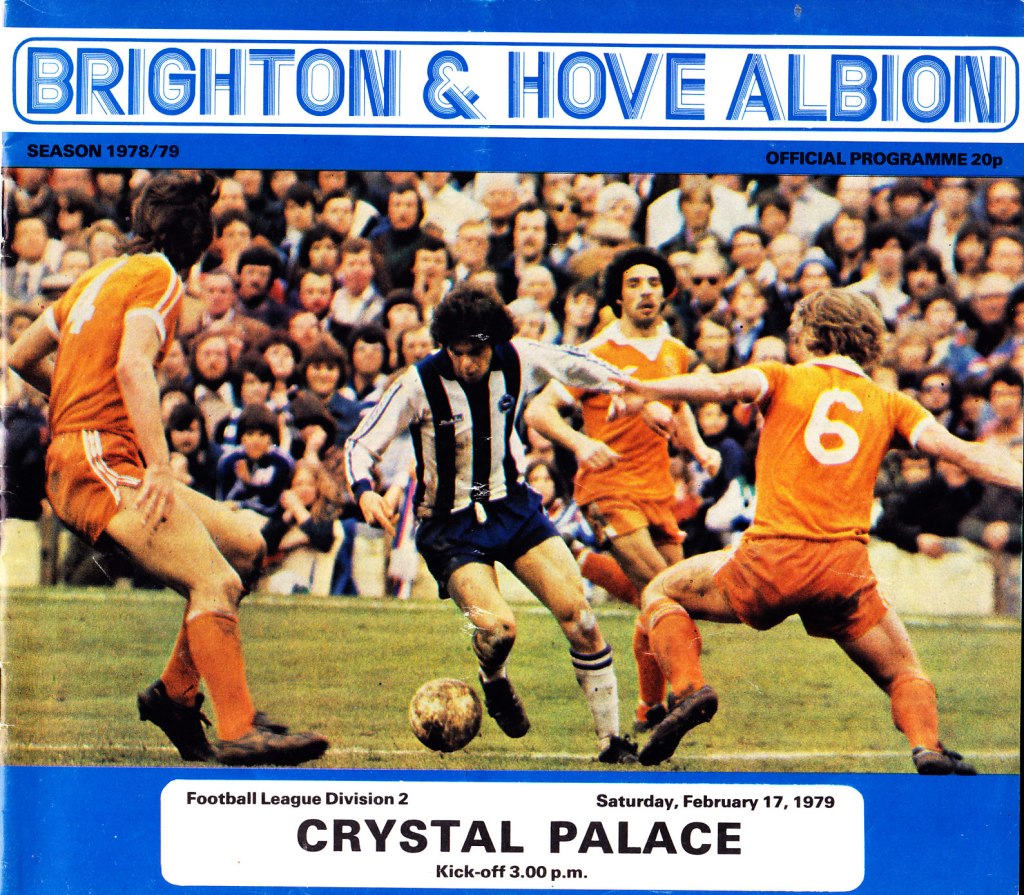
The late 70s also brought me out of School and into full-time employment. This, in theory, gave me more money to spend on programmes. I was conflicted by the need to lavish equal amounts of money on beer, vinyl records and my bumbling attempts at chatting up girls.
Trips to the Goldstone increasingly involved more time in the Pub and less in the programme hut. I progressed to just buying programmes from games I attended. For Brighton, this was home and away and I developed a habit I stick to today. I always bought two programmes – one to read, one to keep (in a plastic sleeve, protected from bending by a piece of cardboard, obviously).
In a miraculous development in the Autumn of 1977, I managed to persuade a young lady to go out with me. The added bonus was that she was an Arsenal season-ticket holder and for a while, Arsenal homes alternated with Albion games. I’ve always harboured an irrational dislike of Arsenal. This was nothing to do with the subsequent collapse of my teenage infatuation but when we did split up, I wasn’t too upset. Maybe it was because our first game in the first division was a 4-0 home hammering by The Gunners.
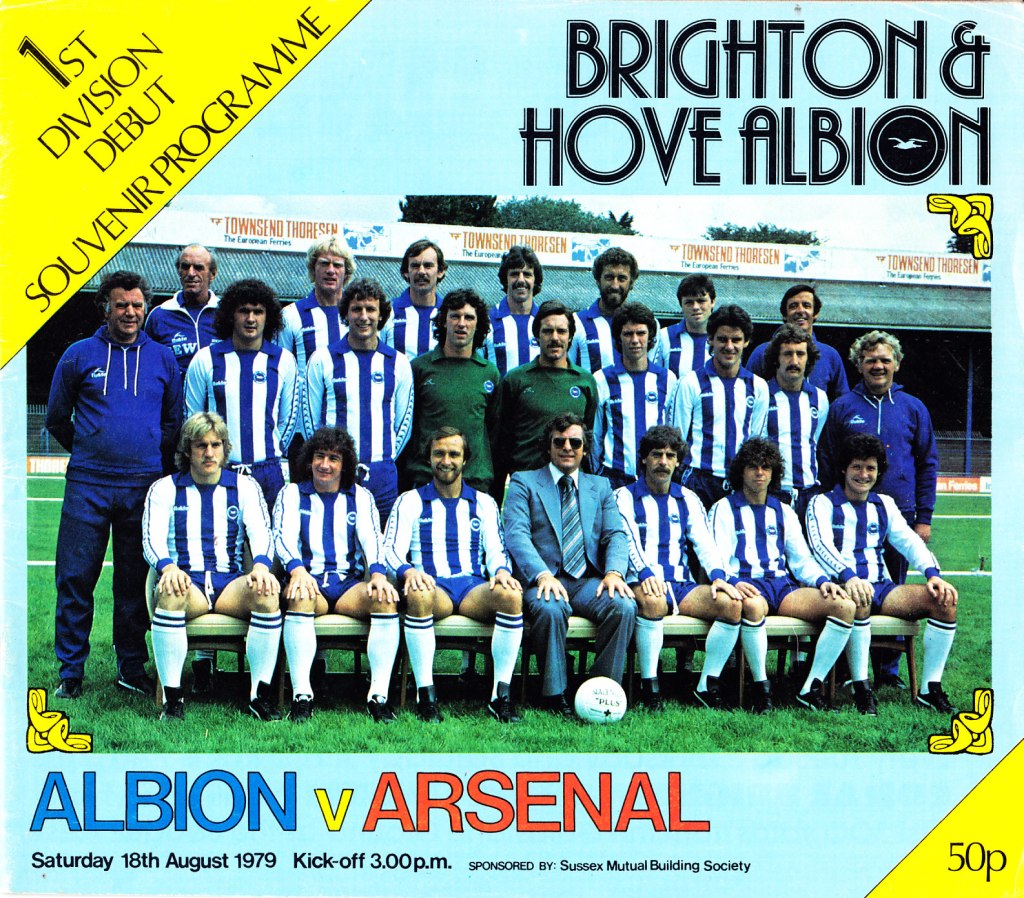
As the 1970s drew to a close, I was beginning to play a lot more sport. I had played Sunday football for a few years but when Saturday football came calling, I gave up my weekly treks across the country. My time with Bracklesham FC in the West Sussex League enabled me to hone my drinking skills, as we travelled to far-flung villages in Sussex to play on pitches better suited to ploughing competitions. I realised that playing football was more important than watching. A friend of my Dad once said to me “You’ll have years to watch from the terraces after you stop playing, make the most of your fitness while you can”. Wise words.
I still made occasional trips to The Goldstone, mainly for midweek games but that changed when my employers Midland Bank, kindly moved me to Jersey in 1983. Most of my possessions went into storage (my parent’s loft) including my programmes.
Programme collecting was rooted in my DNA but it was to be a few years before I was able to revisit my collecting habit.
If you’ve managed to stick with this until now, thank you. I’m going to come back to the next stage of my collecting journey at a later date.
The Cult of the ‘Pirate’ Programme
We have managed just one win in our 11 games against Chelsea over the years. That came in an FA Cup Third Round tie in January 1933. We won the game 2-1, with goals from Arthur Attwood and Tug Wilson. The real story of that campaign came in the fact that, due to an administrative error, we failed to enter the FA Cup in time. Our punishment was to play in the qualifying rounds, starting on 1st October with a 12-0 win over Shoreham.
No less than seven games later, we reached the third round. After Chelsea were sent packing, it took a replay for West Ham United to beat us, the first game at The Goldstone being watched by 32,310. This attendance remained a record for twenty-five years. In total, the FA Cup run that season lasted for nine ties and ELEVEN matches.
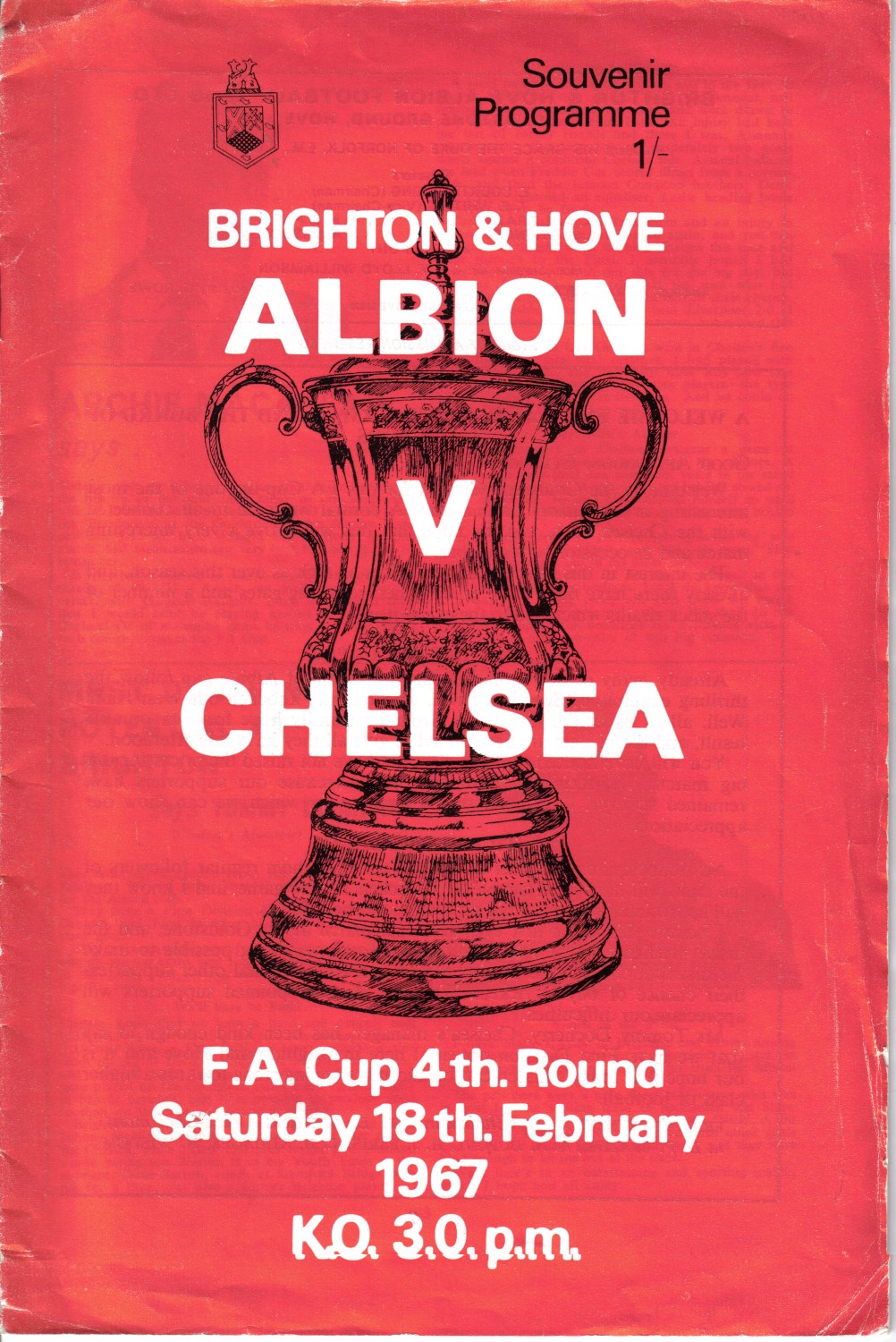
Official Programme
The next time we played Chelsea was also in the FA Cup, this time in the fourth round in the 1966/67 season. The Blues were a huge attraction and Albion decided to issue a special souvenir programme with a bright red cover, strangely. A closer look reveals that the cover was not the only thing different from the usual season issue.
Inside, Albion manager Archie Macaulay welcomes everyone to the game and touches on the problems many fans had encountered in obtaining a ticket. Interest in the tie was huge, with Chelsea including internationals Peter Bonetti and Bobby Tambling (England), and Eddie McCreadie and Charlie Cooke (Scotland). Up front was £100,000 centre-forward Tony Hateley.
Another departure from the norm was a red border around the team listings in the centre pages, accompanied by pictures of both
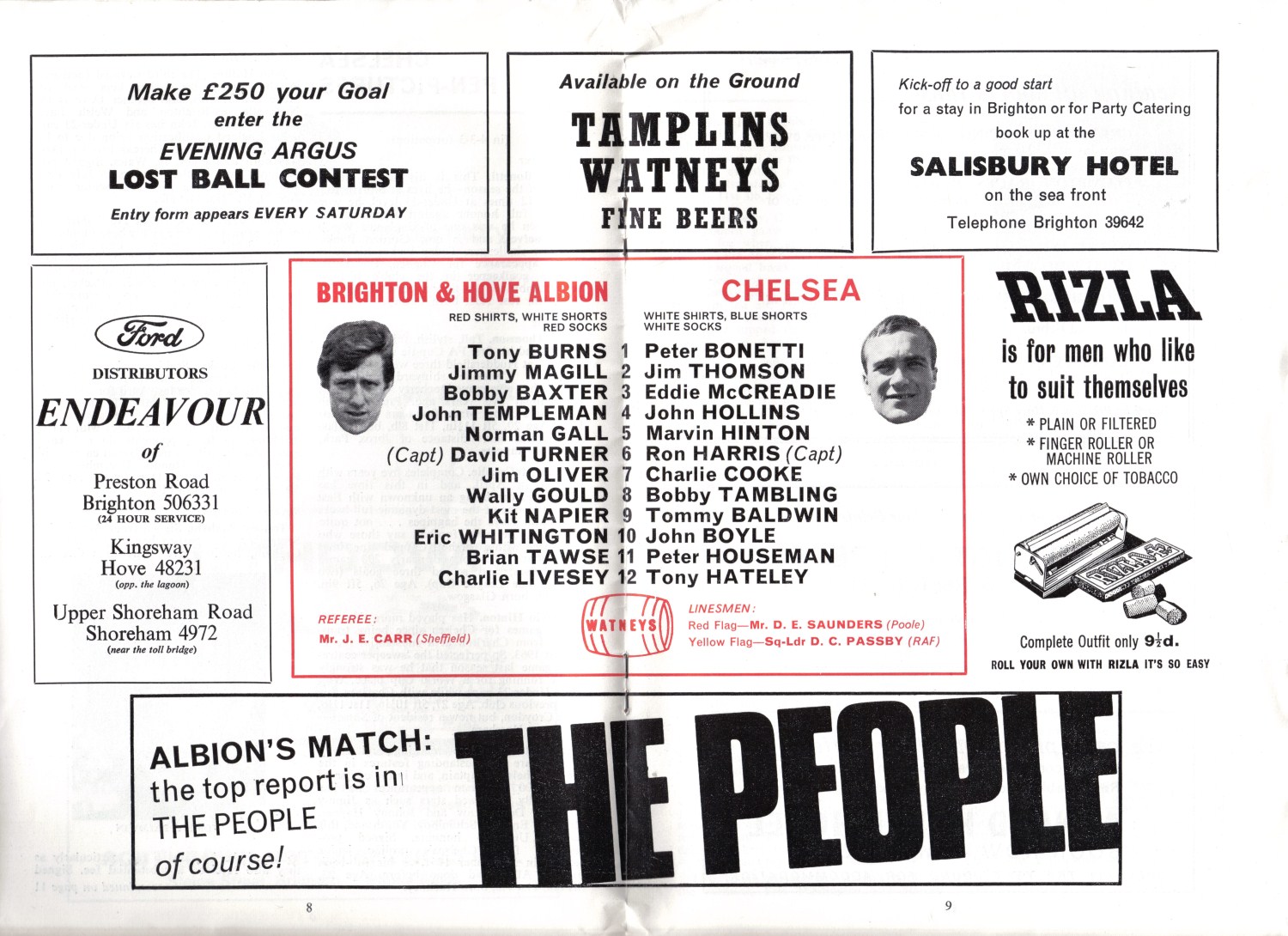
Official Programme – centre pages
captains. Team pictures of both sides were included, as well as pen pictures of both sides. The Albion details would have been familiar to regulars, but the club were obviously trying to be helpful to those who may not have been as well acquainted with Norman Gall (a stylish defender), Dave Turner (fearless in the tackle), and Kit Napier (a smooth-running Scot).
Another feature of many cup-ties in the 50s and 60s was the ‘Pirate’ programme. Completely unauthorised by the club and often lacking in even the most basic club information, these were blatant attempts by unscrupulous publishers to make a bit of cash.
The prominent issues were made by two London-based companies, Starkey (from Hammersmith), and Nicholls of Battersea. Both companies issued programmes for the Chelsea cup-tie.

Starkey Pirate issue
The Starkey issue was 8 pages and had a little information about the match, including ‘How they will line up’ and some tactical insight purporting to come from the Albion manager. The rest of the programme was taken up with pen pictures of various top players of the day, some information on the England national team and a short article on football records. These were programmes designed to be produced quickly for minimum effort and maximum profit.
The Nicholls issue was also 8 pages and lo and behold, much of the information was exactly the same as in the Starkey programme! At least there was some material that was relevant to the competition, with a list of FA Cup
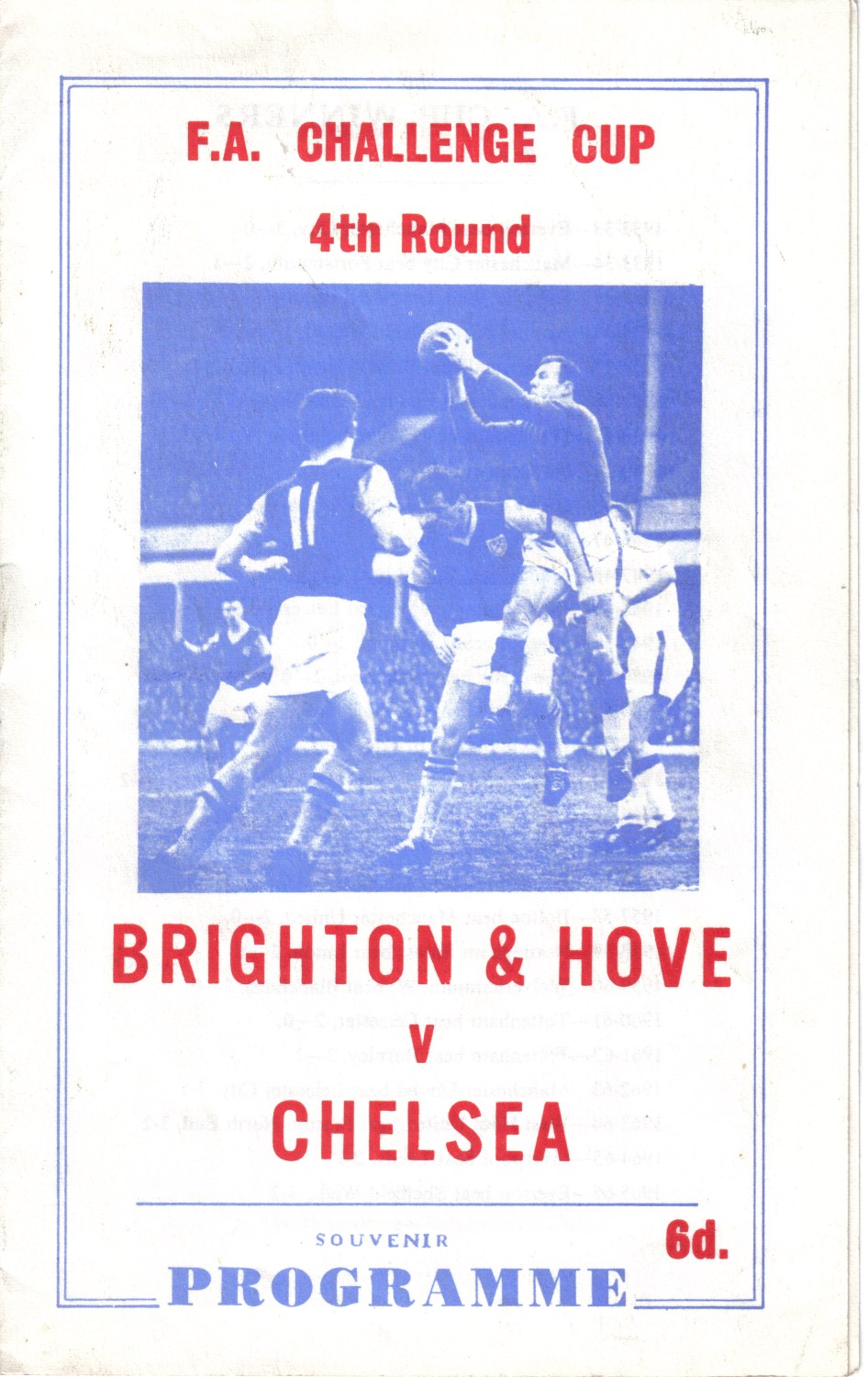
Nicholls Pirate Issue
Winners being shown, but only between 1933 and 1966!
Back to the game, and Albion decided on a novel way of putting the tickets on sale. It was a far cry from loyalty points, season-ticket tiers and Bronze Membership schemes . You just needed to rock up at the Goldstone ticket office, part with your cash and you were in. In addition to this, the club also put them on sale at the reserve fixture with Notts County. This led to a (somewhat dubious) record crowd for a Goldstone reserve-team fixture of 22,229. Queues stretched back from the ticket office right round to the back of the North Stand.
The end result was a crowd of 35,000 for the cup-tie, the second-largest in Goldstone history. They saw Bobby Tambling put Chelsea in front after just 5 minutes. The Londoners held the lead until half time, despite having John Boyle sent off for kicking Wally Gould.

Fans queuing for cup tickets
Dave Turner equalised for Albion early in the second half and Albion thought they had won it, when Brian Tawse thundered a volley past Bonetti. The referee had spotted an infringement however, and the goal was dissallowed. It finished 1-1 and it was off to Stamford Bridge for the replay, just 4 days later.
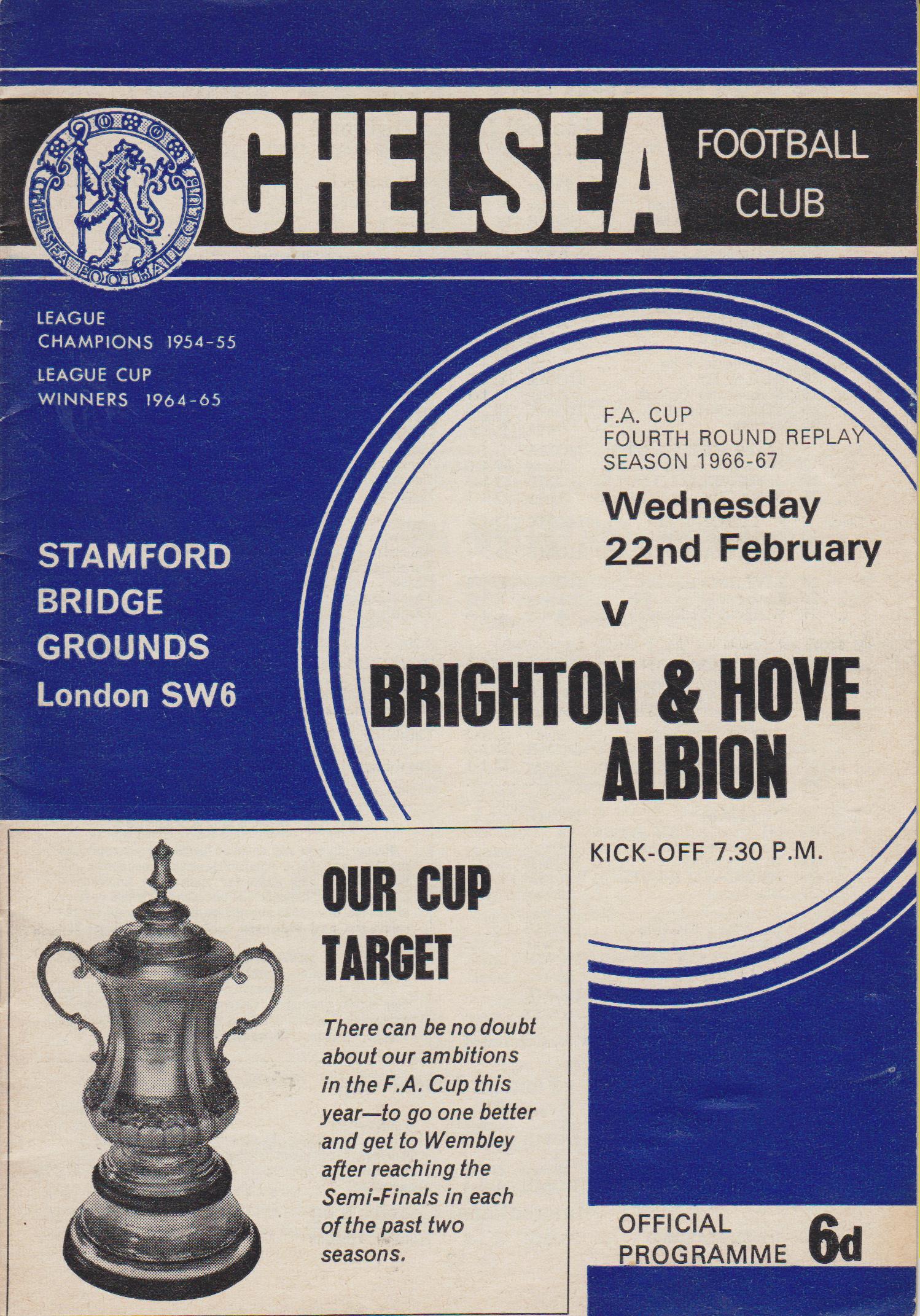
Chelsea replay programme
Another huge crowd turned up, with the gates being shut on 54,852 inside the ground. Chelsea issued their standard programme of the season, with a reference to the club’s ‘Cup Target’ included in a box on the front page.
Albion were unable to repeat their heroics of the first game, although we did come close in the first half. Chelsea eventually ran out 4-0 winners and went on to reach the final, where they were beaten 2-1 by Tottenham Hotspur.
Nicholls also issued a ‘pirate’ programme for the replay. I don’t have one of these but it’s safe to say that it’s probably not a lot different from the one issued for the first game!
The only other Albion fixture that warranted a ‘Pirate’ programme, was the League Cup tie with Wolverhampton Wanderers in September 1969. Apart from a team line-up, there was absolutely no reference to the competition. They even displayed a picture of the wrong trophy on the cover!
The only saving grace for these publications is that, 50 years on, they are sought-after by us collectors!
Full scans of nearly all Albion’s home programmes since the War are available on my SEAGULLS PROGRAMMES website. The picture of the queuing crowds comes from the 1967/68 Supporters Club handbook, also available to view on my website.
Additional material comes from the indispensable book ‘Seagulls! The Story of Brighton and Hove Albion Football Club’ by Tim Carder and Roger Harris. This is truly the bible for all Albion supporters and if you can get hold of a copy, you won’t regret it!
League Football Magazine – 45 years ago this week
Regular readers of this blog will know of my love for the little magazine that was included in club programmes for ten seasons between 1965 and 1975. Starting life at the start of the 1965/66 season as Soccer Review, the magazine changed name to Football League Review just one year later. At the start of the 1972/73 season, we saw another name change, this time to League Football.
 In October 1973, the magazine was in decline. Editorial originality was being diluted and circulation was down. Many clubs were diverting money previous spent on Football League Review to improving their own programme. In Hyder Jawad’s fantastic look at the magazine and it’s charismatic founder Harry Brown, in Soccerama – The Culture of Football No 1, he laments a decline of a magazine that had become ‘uncertain, irrelevant, disorganised, misconceived and ignored’.
In October 1973, the magazine was in decline. Editorial originality was being diluted and circulation was down. Many clubs were diverting money previous spent on Football League Review to improving their own programme. In Hyder Jawad’s fantastic look at the magazine and it’s charismatic founder Harry Brown, in Soccerama – The Culture of Football No 1, he laments a decline of a magazine that had become ‘uncertain, irrelevant, disorganised, misconceived and ignored’.
Having said all this, it was still a valuable source of information for boys all over the country, including this 14-year-old Brighton and Hove Albion fan. My club were struggling after relegation and manager Pat Saward was living on borrowed time.
I was still lapping up the information in the magazine and this week in 1973, there was much to talk about. The cover action came from the recent Manchester City v Norwich City game in the First Division.
 Inside the cover was the latest in a feature called ‘Soccer Homes’. Looking back now, it’s a fascinating glimpse into the world of 1970s football stadiums, most of them looking delightfully ramshackle. Carlisle United’s Brunton Park was no exception, with the main stand pictured, with a slightly incongruous addition at the far end. We are told the capacity is 26,000, with seating for 2,500.
Inside the cover was the latest in a feature called ‘Soccer Homes’. Looking back now, it’s a fascinating glimpse into the world of 1970s football stadiums, most of them looking delightfully ramshackle. Carlisle United’s Brunton Park was no exception, with the main stand pictured, with a slightly incongruous addition at the far end. We are told the capacity is 26,000, with seating for 2,500.
 Next comes a look at the travels undertaken by our clubs in Europe, with Liverpool making their 10th successive appearance in European competition.
Next comes a look at the travels undertaken by our clubs in Europe, with Liverpool making their 10th successive appearance in European competition.
Outside business interests were, for many players, restricted to a foray into Pub ownership or possibly a restaurant. In the 1960s, players like George Best (who else) and Mike Summerbee had gone into the fashion industry, and more players were going down this route, in search of something to supplement their football income.
Notts County defender David Needham, described as a ‘strapping six footer, runs a ‘thriving womens fashion stall at the heart of Leicester Market’ and had recently opened a shop. Footballers were well paid, but it was a million miles away from the riches seen by today’s players.  Needham touches on this, saying “players face enormous problems when the time comes to hang up their boots. I’ve got security outside the game which enables me to enjoy my football without having to worry about what i’m going to do when it is all over”. Needham and his wife also breed horses and had recently opened a riding school. A busy man, on and off the pitch.
Needham touches on this, saying “players face enormous problems when the time comes to hang up their boots. I’ve got security outside the game which enables me to enjoy my football without having to worry about what i’m going to do when it is all over”. Needham and his wife also breed horses and had recently opened a riding school. A busy man, on and off the pitch.
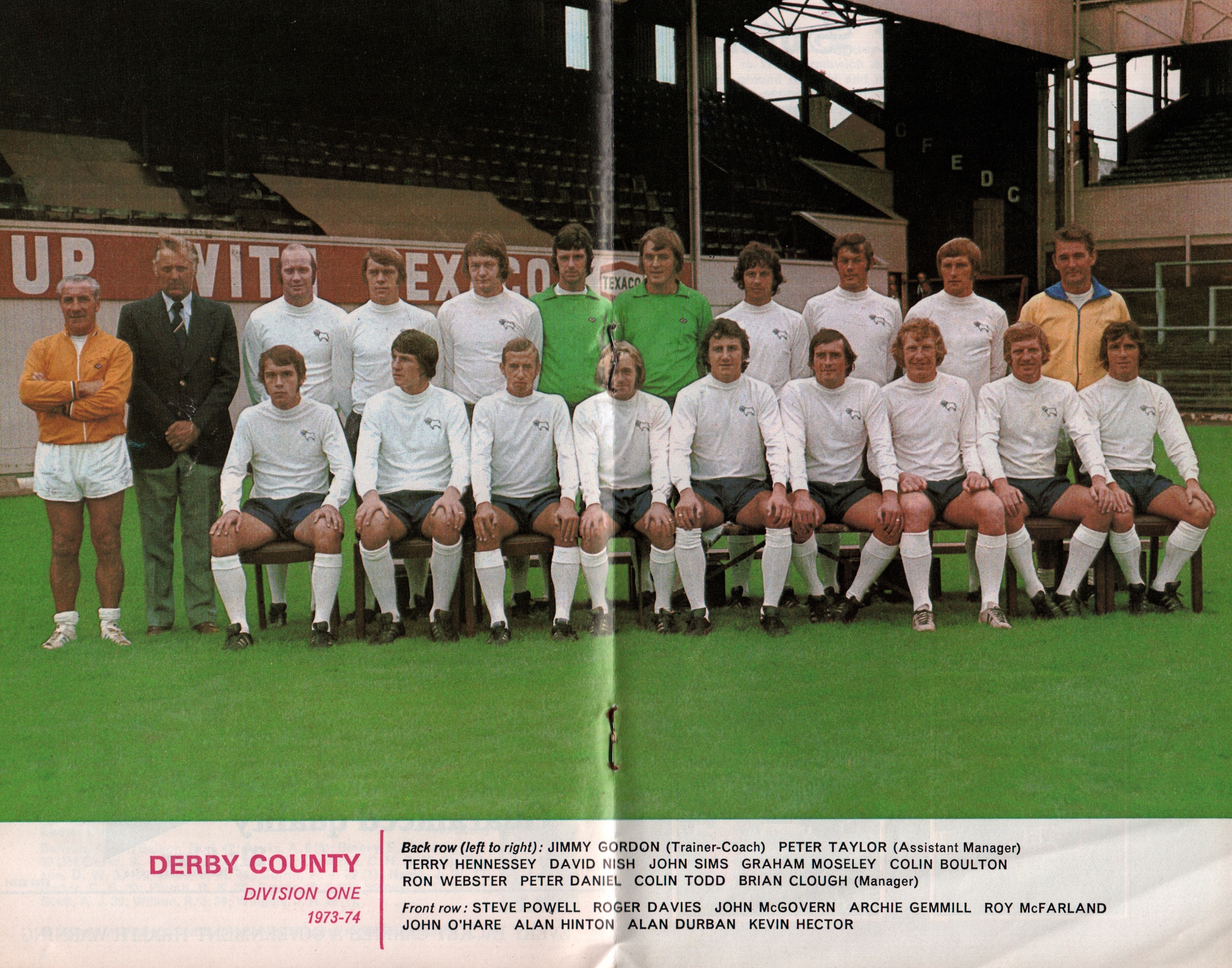 The usual cigarette advert comes before the team picture in the centre pages. The featured team in October 1973 was Derby County. League champions in 1972, they reached the semi-final of the European Cup the following season. The team included great players such as Roy McFarland, Kevin Hector and Archie Gemmill but it was the managerial team that took many of the headlines. Brian Clough and Peter Taylor were pictured with the players, but little did we know that it was not going to last at The Baseball Ground. Tensions were high between Clough and Derby Chairman Sam Longson and just days after this picture appeared in League Football, Clough and Taylor were on their way………………. to Brighton & Hove Albion.
The usual cigarette advert comes before the team picture in the centre pages. The featured team in October 1973 was Derby County. League champions in 1972, they reached the semi-final of the European Cup the following season. The team included great players such as Roy McFarland, Kevin Hector and Archie Gemmill but it was the managerial team that took many of the headlines. Brian Clough and Peter Taylor were pictured with the players, but little did we know that it was not going to last at The Baseball Ground. Tensions were high between Clough and Derby Chairman Sam Longson and just days after this picture appeared in League Football, Clough and Taylor were on their way………………. to Brighton & Hove Albion.
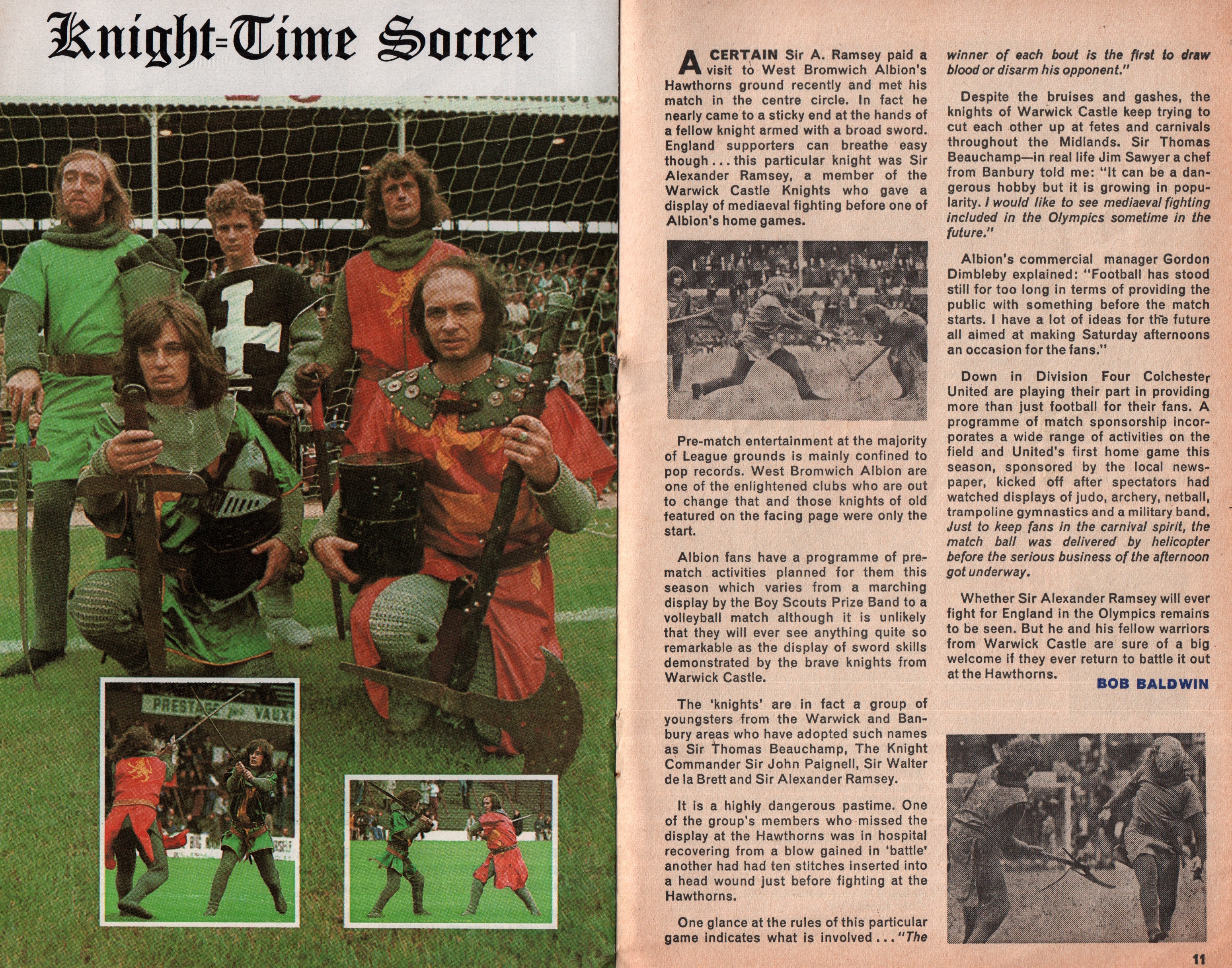 A feature of early volumes of the magazine, was the descent into the slightly weird and wonderful side of football. In October 1973, we are taken to The Hawthorns, and a display of ‘medieval fighting’, given before a recent home game. West Bromwich Albion were keen to entertain their fans before matches, with displays from various local organisations. Albion’s commercial manager says the jousting is not the end. “I have lots of ideas for the future all aimed at making Saturday afternoons an occasion for the fans”.
A feature of early volumes of the magazine, was the descent into the slightly weird and wonderful side of football. In October 1973, we are taken to The Hawthorns, and a display of ‘medieval fighting’, given before a recent home game. West Bromwich Albion were keen to entertain their fans before matches, with displays from various local organisations. Albion’s commercial manager says the jousting is not the end. “I have lots of ideas for the future all aimed at making Saturday afternoons an occasion for the fans”.
The letters page always provided a rich vein of material and this week in 1973 was no exception. JG Brown from Rickmansworth urges people to ‘stay seated when a goal is scored or when there are exciting incidents”, and a correspondent from Prestwich puts forward a case for the Stretford End having more atmosphere than Anfield’s Kop end.
A slightly ‘left-field’ suggestion comes from P Dowling from Hambledon, Lancashire. In an attempt to increase the number of goals scored, Mr Dowling suggests that goalkeepers be banned from handling the ball. An interesting idea!
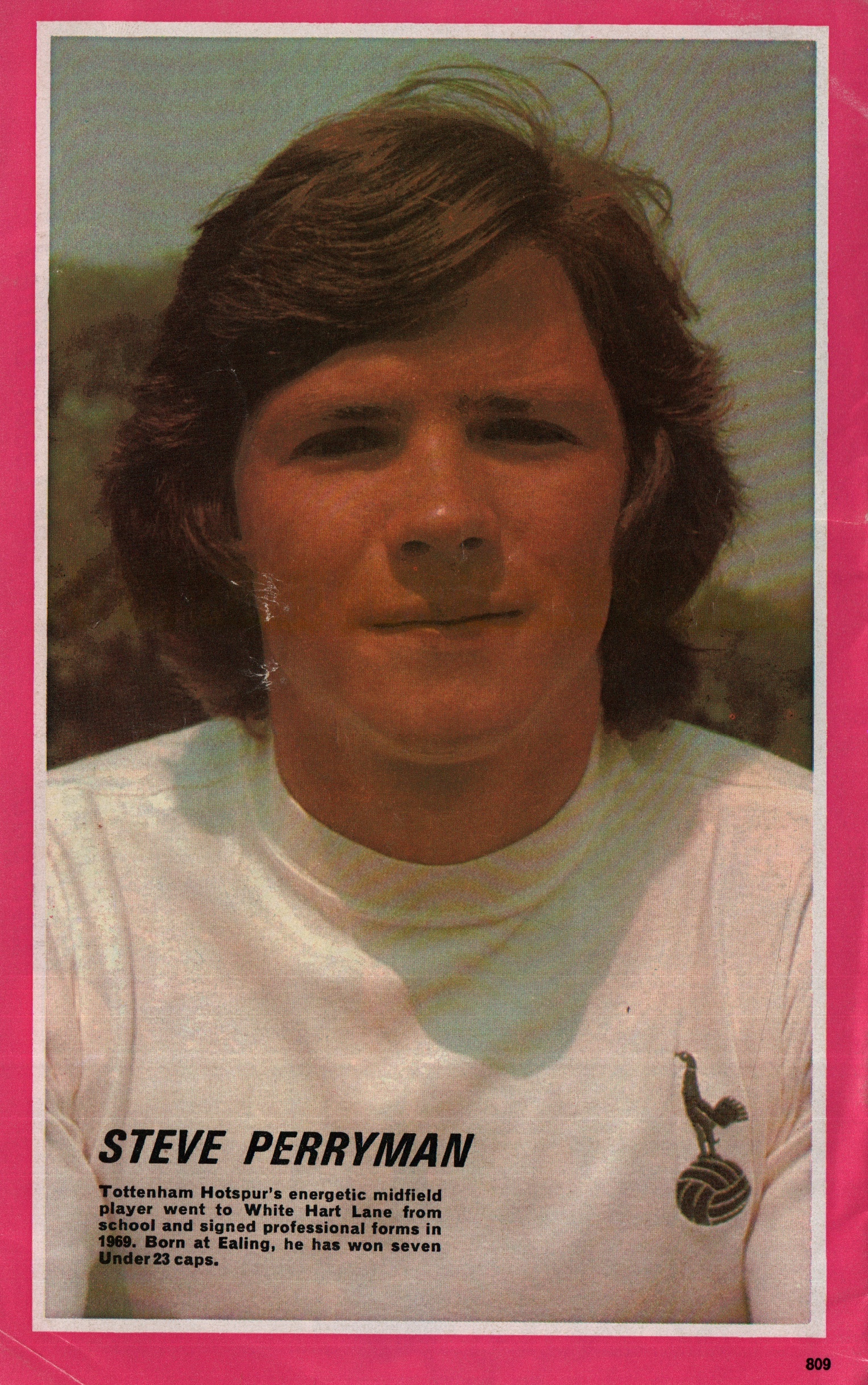 Football League Review/League Football magazine was a rich source of photographs, not just team lineups. The back cover always carried a player picture and for this week, it is a young Steve Perryman, ‘Tottenham Hotspur’s energetic midfield player’.
Football League Review/League Football magazine was a rich source of photographs, not just team lineups. The back cover always carried a player picture and for this week, it is a young Steve Perryman, ‘Tottenham Hotspur’s energetic midfield player’.  Inside the back cover is action from a game between Leeds United and Liverpool. Ian Callaghan is pictured with the ball, as Trevor Cherry moves in to tackle.
Inside the back cover is action from a game between Leeds United and Liverpool. Ian Callaghan is pictured with the ball, as Trevor Cherry moves in to tackle.
So there we have it, a glimpse of life in the Football League, 45 years ago this week.
With thanks to the article in ‘Soccerama – The Culture of Football‘, edited by Hyder Jawad, in which he delves into the colourful history of the Football League Review and in particular, its founder Harry Brown.
Fifty years, Fifty Programmes – 1973/74
After my brush with the law at the end of 72/73, my trips to The Goldstone the following season seemed to be in jeopardy. Even though I write about it quite flippantly now, at the time I was mortified and knew I had really let my parents down.
A long summer of working at Butlins to save money for the fine that was coming my way helped to smooth the waters, and by the time we got to the beginning of August, I felt sure my parents would let me go to football again. The court case for my misdemeanour came and I ended up with a fine of £3. Yes, that’s right, THREE POUNDS.
In a strange way, I felt almost cheated. I had worked my socks off over the summer and had about £70 saved. In 1973 that was a decent amount of money. Looking at an inflation calculator, that is the equivalent of between £600 and £800 in today’s reckoning.
I was relieved, obviously, and hoped my Mum & Dad would relent as far as Albion were concerned. They did, but only up to a point. They were prepared to let me go to the games, but I wasn’t allowed any contact with the people with whom I had misbehaved. That seemed a small price to pay and if I accidentally ran into them at the games, then that was hardly my fault.
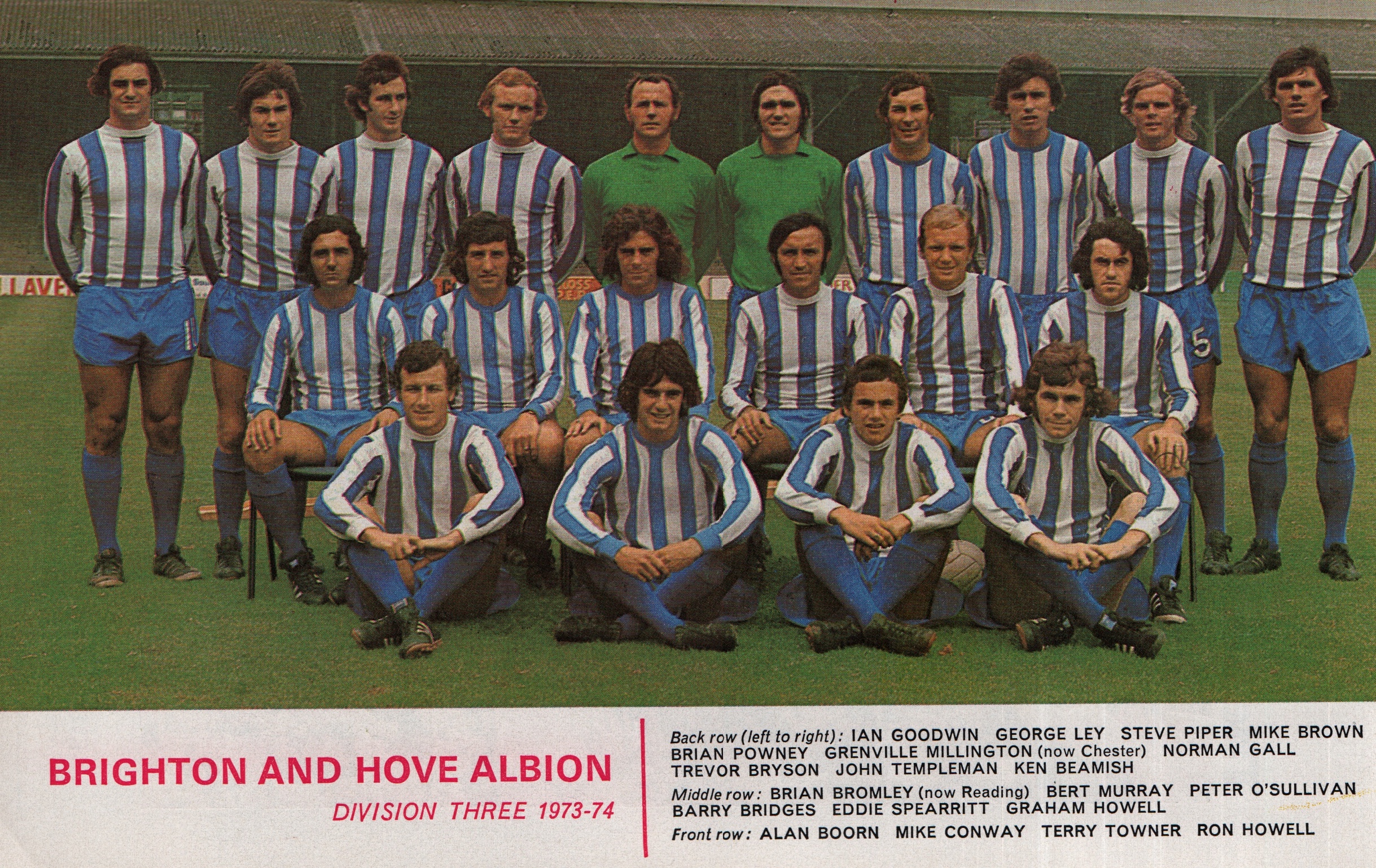 So there I was, back on the train every other week, with Albion back in the third division. Pat Saward was still in charge but he seemed to be on borrowed time after our abject season in Division Two. We lost the first six home games and although our form was, bizarrely, better away from The Goldstone, it seemed we were lurching into another crisis. It was pretty dismal and despite the first home win of the season on 20th October, Saward was sacked a couple of days later.
So there I was, back on the train every other week, with Albion back in the third division. Pat Saward was still in charge but he seemed to be on borrowed time after our abject season in Division Two. We lost the first six home games and although our form was, bizarrely, better away from The Goldstone, it seemed we were lurching into another crisis. It was pretty dismal and despite the first home win of the season on 20th October, Saward was sacked a couple of days later.
I’ve said before in these posts that my dad was a PE Lecturer at the teacher training college in Bognor and for some reason, he asked if I wanted to take a referee’s course. I agreed and became a qualified referee. I started off as a linesman in the Sussex County League, with trips to Wick, Lancing, Selsey and Steyning, among others. The good news was I got paid for this but the bad news was that it restricted my Saturdays at The Goldstone.
This all paled into insignificance with the news that our new manager was going to be Brian Clough. That’s right, the most high-profile manager in the country was going to be in charge of Brighton & Hove Albion. To give a bit of context, a comparable modern-day scenario would be this:
Pep Guardiola wins the Premier League and the following season reaches the semi-final of the Champions League. In the summer of that season he has a massive row with City’s owners and ends up leaving the club. Two months later, he is unveiled as the new manager of Gillingham. It sounds utterly ridiculous but that is exactly what happened in November 1973.
As an aside, there is a brilliant new book out, called Bloody Southerners, by Spencer Vignes, that looks at Clough’s time (with his assistant Peter Taylor) at Brighton. It’s a brilliant read and highly recommended.
So there we were, towards the bottom of the third division with Brian Clough and Peter Taylor in charge. Mental. I guess we were all expecting they would transform our fortunes and we would go on a spectacular unbeaten run and storm back into Division 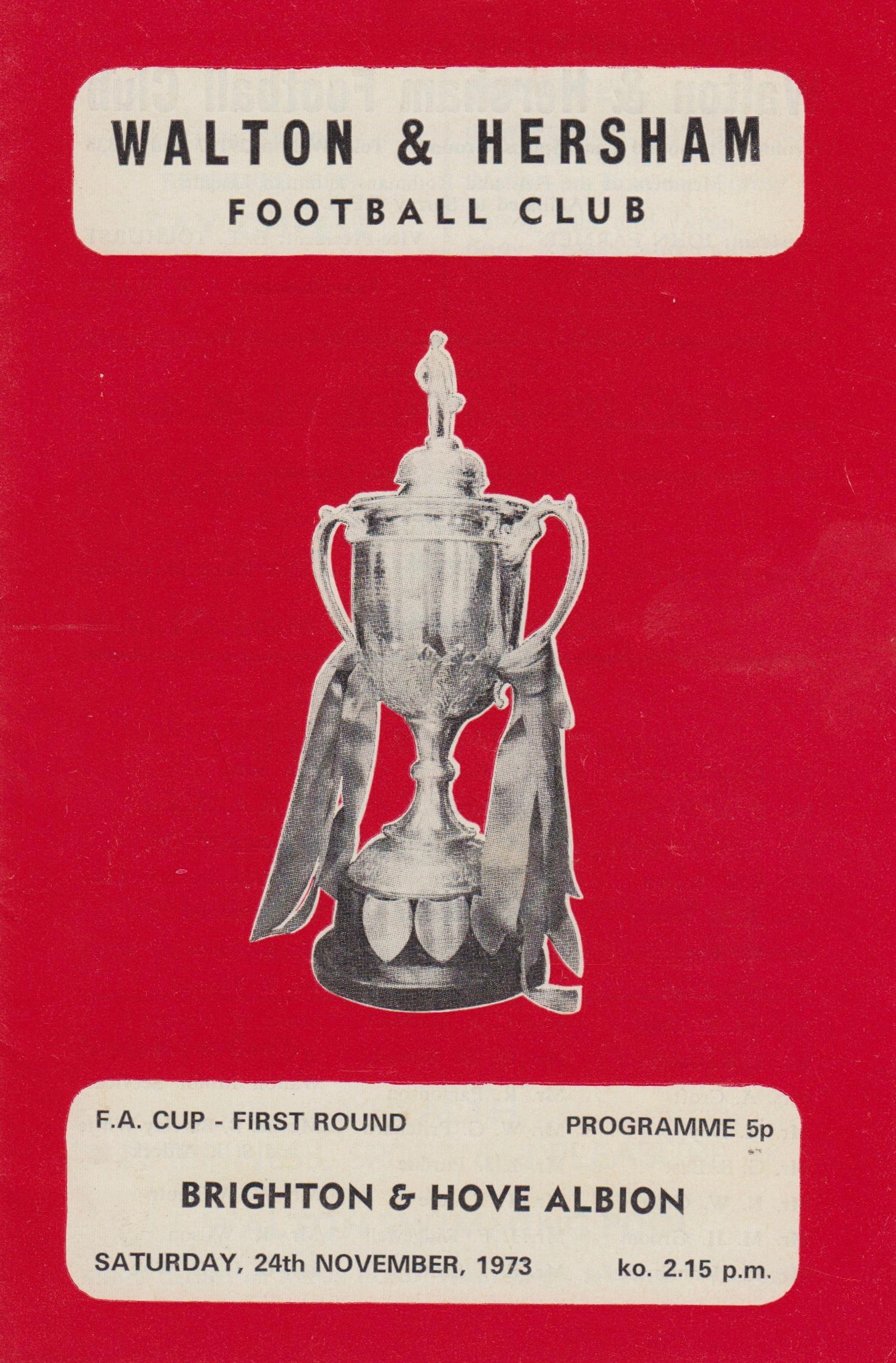 Two. It obviously doesn’t (and didn’t) pan out like that and results were patchy at best. We came to the last week in November with an FA Cup tie against non-league Walton & Hersham to look forward to. This just added to the craziness and although we couldn’t win the game, the replay four days later was surely a foregone conclusion.
Two. It obviously doesn’t (and didn’t) pan out like that and results were patchy at best. We came to the last week in November with an FA Cup tie against non-league Walton & Hersham to look forward to. This just added to the craziness and although we couldn’t win the game, the replay four days later was surely a foregone conclusion.
Wrong.
The game was played in the afternoon, as the country was in the grip of a power crisis that meant the floodlights could not be used. Despite this, a crowd of 9,657 turned up. The kick-off time led to a strangely quiet atmosphere, as the normally vociferous north stand was empty of all the schoolchildren who would normally have been there. With this backdrop, we fell behind to a goal from headmaster Russell Perkins. The score stayed that way until eight minutes from time when Clive Foskett, a 28-year-old joiner working at the Natural History Museum, scored a second. And a third. And a fourth. It was a nightmare and I can only imagine what Clough had to say to the players afterwards.
Foskett, a 28-year-old joiner working at the Natural History Museum, scored a second. And a third. And a fourth. It was a nightmare and I can only imagine what Clough had to say to the players afterwards.
Just three days later, we had a chance to make amends with the visit of Bristol Rovers. They were top of the table and in free-scoring form, but surely Clough and Taylor would be able to rally the players so they could bounce back from their cup humiliation.
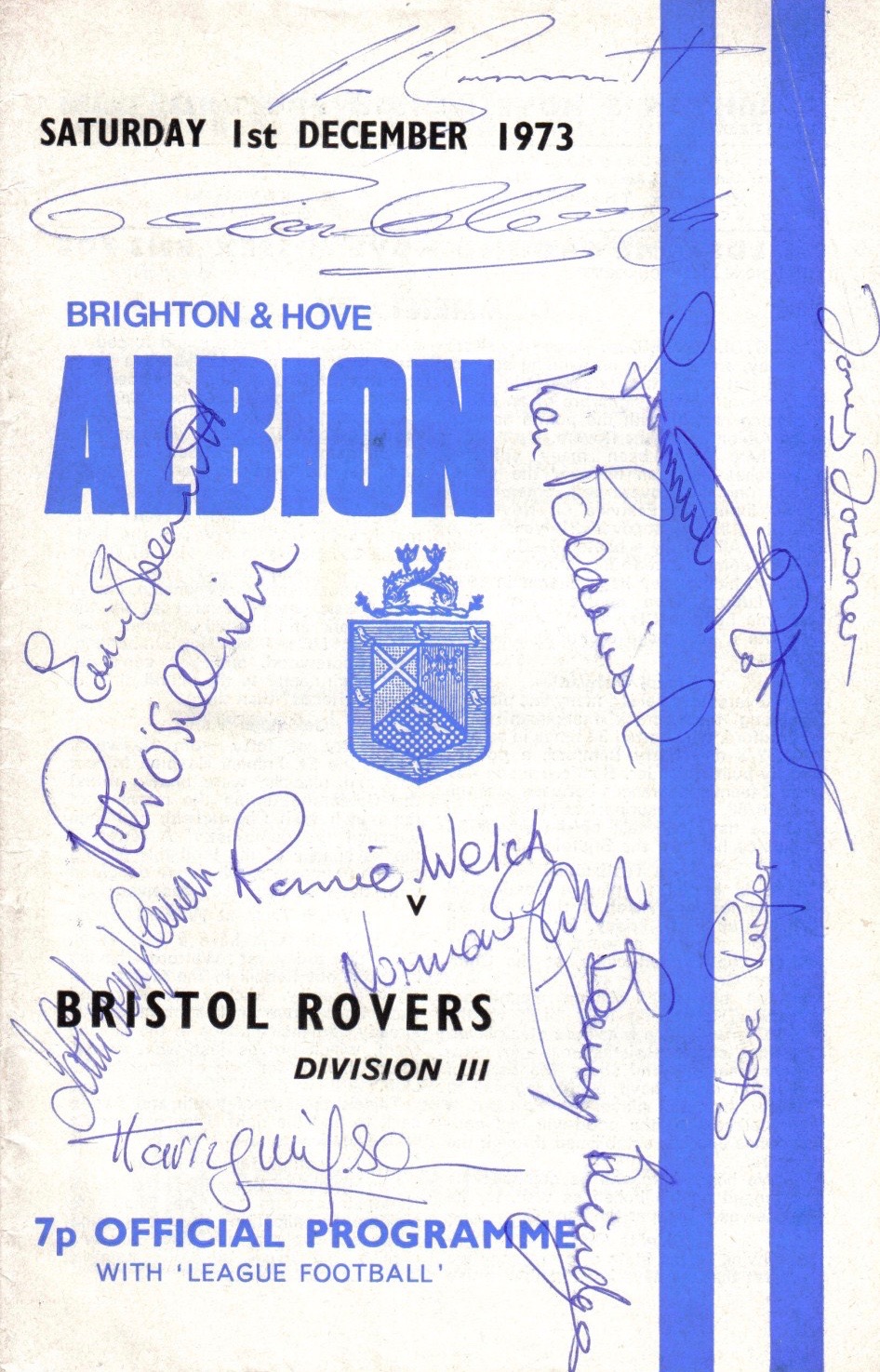 These days, we can look to the manager’s notes in the programme for an idea of how the team have responded on the training ground. Unfortunately, Mr Clough felt that such things were beneath him so we will never know. We had to make do with the pithy column entitled ‘Secretary’s Desk’. The offering for the Bristol Rovers game, brought news of a proposal for managers to ‘meet regularly to discuss the various aspects of the game to put forward more ideas to the administration about the running of the game’. Riveting stuff.
These days, we can look to the manager’s notes in the programme for an idea of how the team have responded on the training ground. Unfortunately, Mr Clough felt that such things were beneath him so we will never know. We had to make do with the pithy column entitled ‘Secretary’s Desk’. The offering for the Bristol Rovers game, brought news of a proposal for managers to ‘meet regularly to discuss the various aspects of the game to put forward more ideas to the administration about the running of the game’. Riveting stuff.
1970s print deadlines meant there was no mention at all of the midweek debacle and Clough made just a couple of changes. Steve Piper had been substituted in midweek and his place was taken by Ken Beamish. Tony Towner, arguably the only player who came out of the FA Cup game with any credit, kept his place after he had come on for Piper. Other than that, it 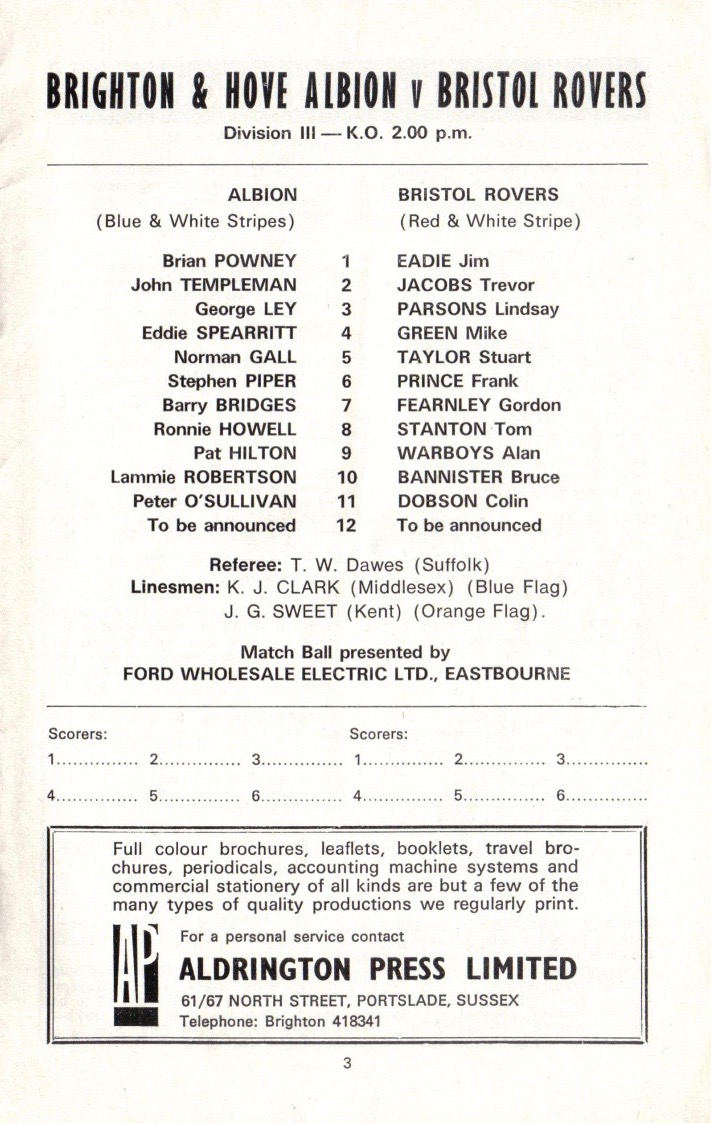 was up to the players to show they could bounce back. To add to the feeling that we were under the spotlight, the Big Match cameras were at the Goldstone – surely nothing could go wrong?
was up to the players to show they could bounce back. To add to the feeling that we were under the spotlight, the Big Match cameras were at the Goldstone – surely nothing could go wrong?
Ooops.
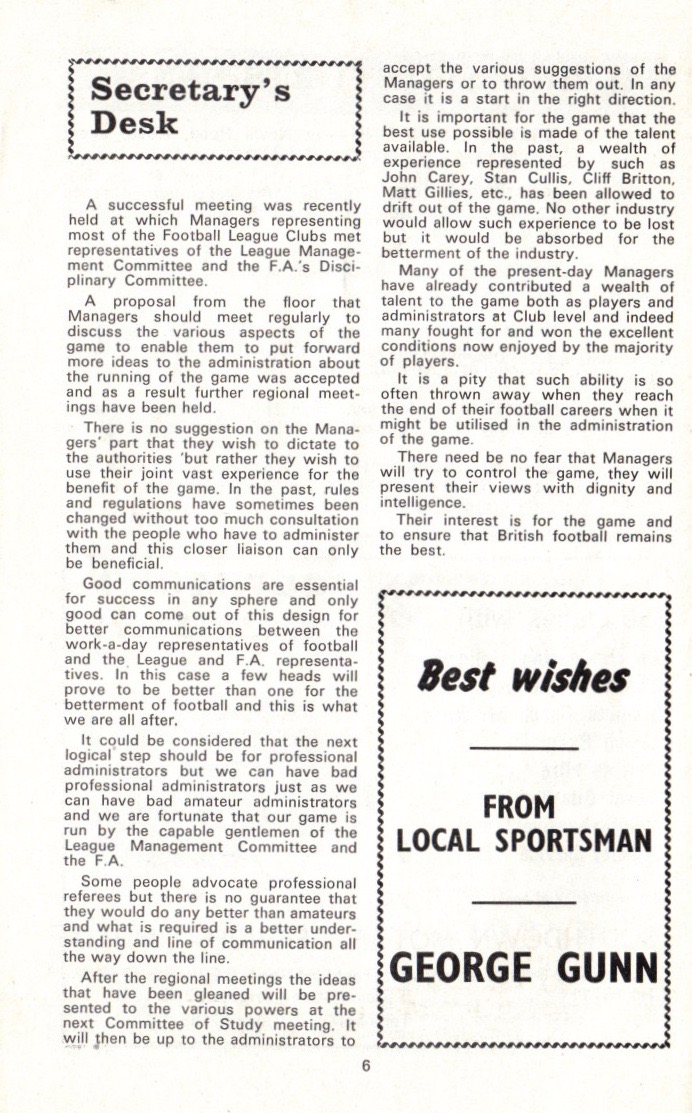 The Bristol Rovers strike-force ran riot. Bruce Bannister scored a hat-trick and Alan Warboys four as Rovers pulverised us 8-2. We were 5-1 down at half-time and had absolutely no answer to Rovers. I was there because I didn’t have any refereeing commitments and it was a nightmare. Far from being a team ready to push on up the league, we were fast becoming a laughing stock. Clough was quoted as saying “It was the most humiliating 90 minutes of my career. We have plans to sign players but nobody will be signed for the sake of signing. I will play before we do that, or my bairn will…..” Young Nigel turned out to be a very good player but at seven years old, he wasn’t quite ready, even for a team that had just lost 8-2.
The Bristol Rovers strike-force ran riot. Bruce Bannister scored a hat-trick and Alan Warboys four as Rovers pulverised us 8-2. We were 5-1 down at half-time and had absolutely no answer to Rovers. I was there because I didn’t have any refereeing commitments and it was a nightmare. Far from being a team ready to push on up the league, we were fast becoming a laughing stock. Clough was quoted as saying “It was the most humiliating 90 minutes of my career. We have plans to sign players but nobody will be signed for the sake of signing. I will play before we do that, or my bairn will…..” Young Nigel turned out to be a very good player but at seven years old, he wasn’t quite ready, even for a team that had just lost 8-2.
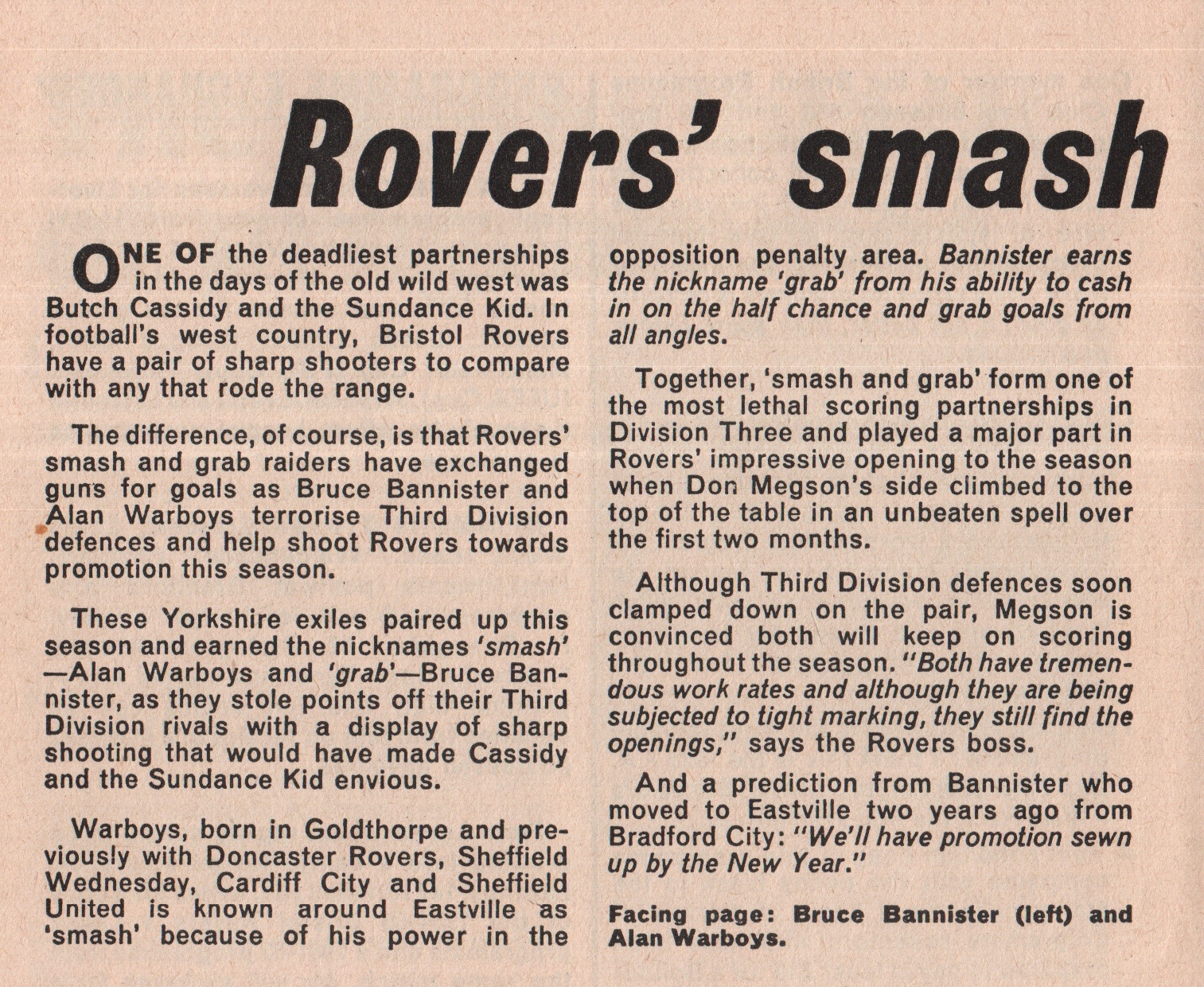
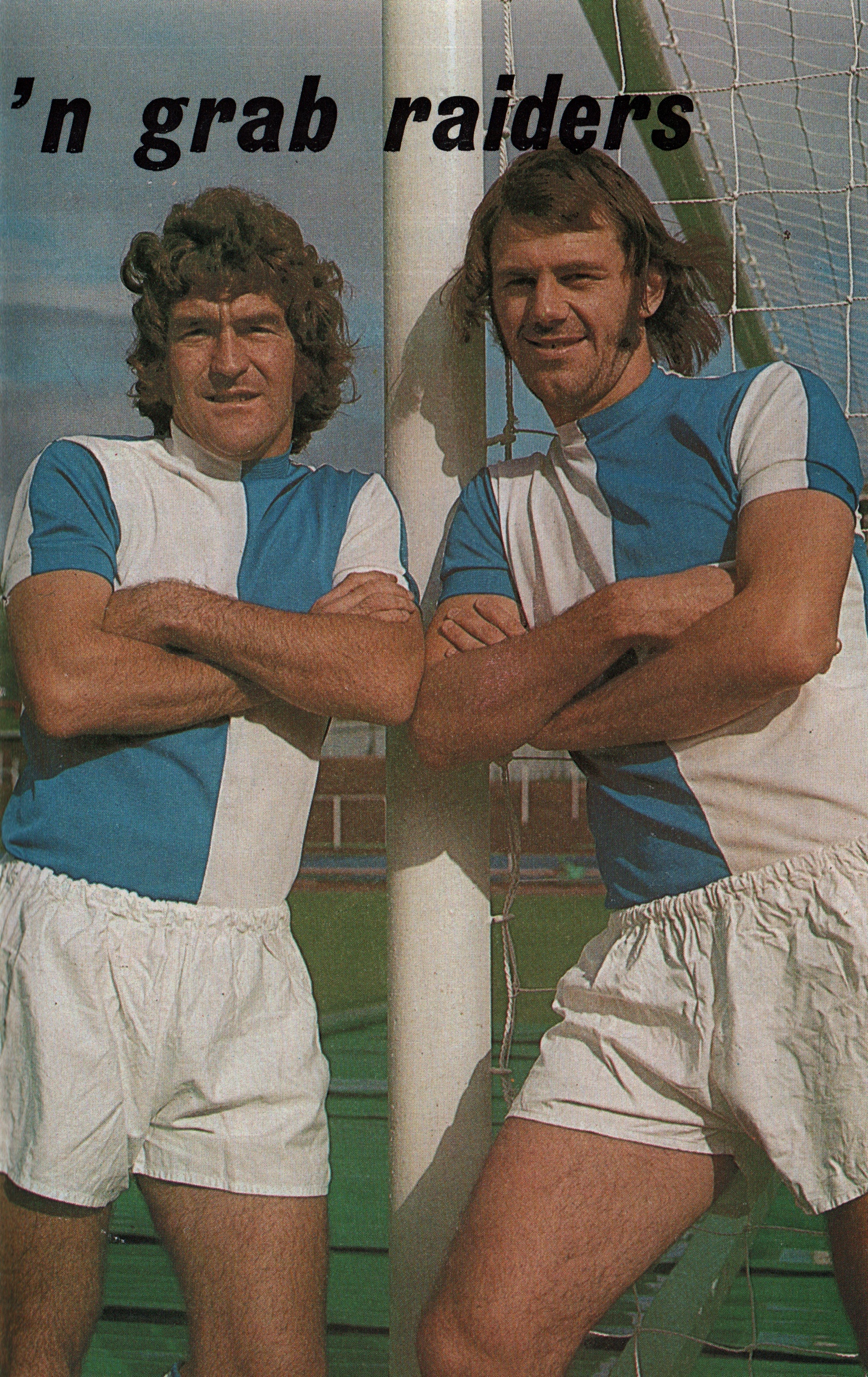 For me, it was a real shock to the system and as the season went on, things never really improved. We finished 19th and although we were eight points clear of the drop, it was obvious that Mr Clough was not the messiah we all thought. He jumped ship in the summer of 1974, to take up the manager’s job at Leeds United. How did that one go for you Brian?
For me, it was a real shock to the system and as the season went on, things never really improved. We finished 19th and although we were eight points clear of the drop, it was obvious that Mr Clough was not the messiah we all thought. He jumped ship in the summer of 1974, to take up the manager’s job at Leeds United. How did that one go for you Brian?
Tellingly, Pater Taylor stayed. He felt there was unfinished business on the south coast and over the next two seasons he built a team that that would go on to great things.
But more of that another time. Lets just leave 1973/74 behind and try and forget about it.
But do buy the book. Bloody Southerners by Spencer Vignes.
The Football League Review – This week in 1968
 Fifty years ago, the Football League Review magazine was in its heyday. From humble beginnings in August 1965, Harry Brown’s mouthpiece for news from around the Football League, had developed into an essential addition to match day programmes.
Fifty years ago, the Football League Review magazine was in its heyday. From humble beginnings in August 1965, Harry Brown’s mouthpiece for news from around the Football League, had developed into an essential addition to match day programmes.
The 1968/69 season was the fourth season of publication, but the third as the Football League Review (FLR). Volume three carried a colour photo on the cover, below the distinctive yellow masthead.
The cover photographs delved into the slightly different, and Issue number 10, released on 12 October 1968, was no exception.
We see a rag-tag group of children, who call themselves ‘The Rawcliffe Street Gang’. Their job was to act as ‘car-watchers’ for visitors to Maine Road, home of League Champions Manchester City. As the article states; ‘the youngsters, ranging in age from four to 14, offer to look after parked cars while owners are watching the game’.
They proudly claim a ‘100 per cent insurance record’ and Tommy Griffiths is quoted as saying “We would call a Policeman pronto” if confronted with a prospective car thief.
Inside, the First Division ‘Crowd Behaviour Award’ went to Coventry City, with chairman Derrick Robbins saying “We don’t regard the chap who passes through the turnstiles as simply a fan, he is an important part of the club”. Hooliganism was becoming a problem and clubs were doing all they could to keep it at bay. The divisional winners of the award were Crystal Palace, Walsall and Rochdale.
Derrick Robbins saying “We don’t regard the chap who passes through the turnstiles as simply a fan, he is an important part of the club”. Hooliganism was becoming a problem and clubs were doing all they could to keep it at bay. The divisional winners of the award were Crystal Palace, Walsall and Rochdale.
The magazine editorial looked at the possibility of a European League in the foreseeable future. After Manchester United and Leeds United had won the European Cup and Inter-Cities fairs Cup respectively, it was felt that success in Europe was a by-product of domestic achievement but that the more important task was continued success at home, rather then breaking away into Europe. Fifty years on, the debate still rages.
 ‘The People I Meet’ took Assistant Editor Bob Baldwin to The Shay, home of Halifax Town. His first impression is of the ‘feminine touch making its presence felt’. This was due to to the only woman secretary in the football league. Pauline Hicks believed she had cracked the barrier into one of man’s few remaining strongholds. The article goes on to ask how the players feel about having a woman about the place. You can’t help feeling that the casual sexism throughout the article would probably do more harm than good. Pauline didn’t exactly help matters. Instead of focusing on her undoubted administrative skills, she preferred to tell us that “We are so much better at keeping things nice and tidy”
‘The People I Meet’ took Assistant Editor Bob Baldwin to The Shay, home of Halifax Town. His first impression is of the ‘feminine touch making its presence felt’. This was due to to the only woman secretary in the football league. Pauline Hicks believed she had cracked the barrier into one of man’s few remaining strongholds. The article goes on to ask how the players feel about having a woman about the place. You can’t help feeling that the casual sexism throughout the article would probably do more harm than good. Pauline didn’t exactly help matters. Instead of focusing on her undoubted administrative skills, she preferred to tell us that “We are so much better at keeping things nice and tidy”
Club Call visits Notts County, the oldest club in the league, for a look round and a brief history lesson. Across the page, Stoke City manager Tony Waddington talks about how he escapes from the rigours of management in the First Division. In a far cry from the millionaire lifestyle of today’s bosses, we learn that Waddington ‘has taken a caravan near the delightful beach (of Abersoch in North Wales) up against the mountains’
 ‘Inquiry’ looks at the increasing role of public relations in football, and the number of managers making their voices heard in the media. Many managers had been taking to the pages of their match programme to get their messages across, with Southend United manager Ernie Shepherd pulling no punches in his analysis of a recent performance. He says “this was disgraceful and few, if any, of our players came out with credit”. I wonder what he would make of todays outbursts by the likes of Jose Mourinho and Jurgen Klopp?
‘Inquiry’ looks at the increasing role of public relations in football, and the number of managers making their voices heard in the media. Many managers had been taking to the pages of their match programme to get their messages across, with Southend United manager Ernie Shepherd pulling no punches in his analysis of a recent performance. He says “this was disgraceful and few, if any, of our players came out with credit”. I wonder what he would make of todays outbursts by the likes of Jose Mourinho and Jurgen Klopp?
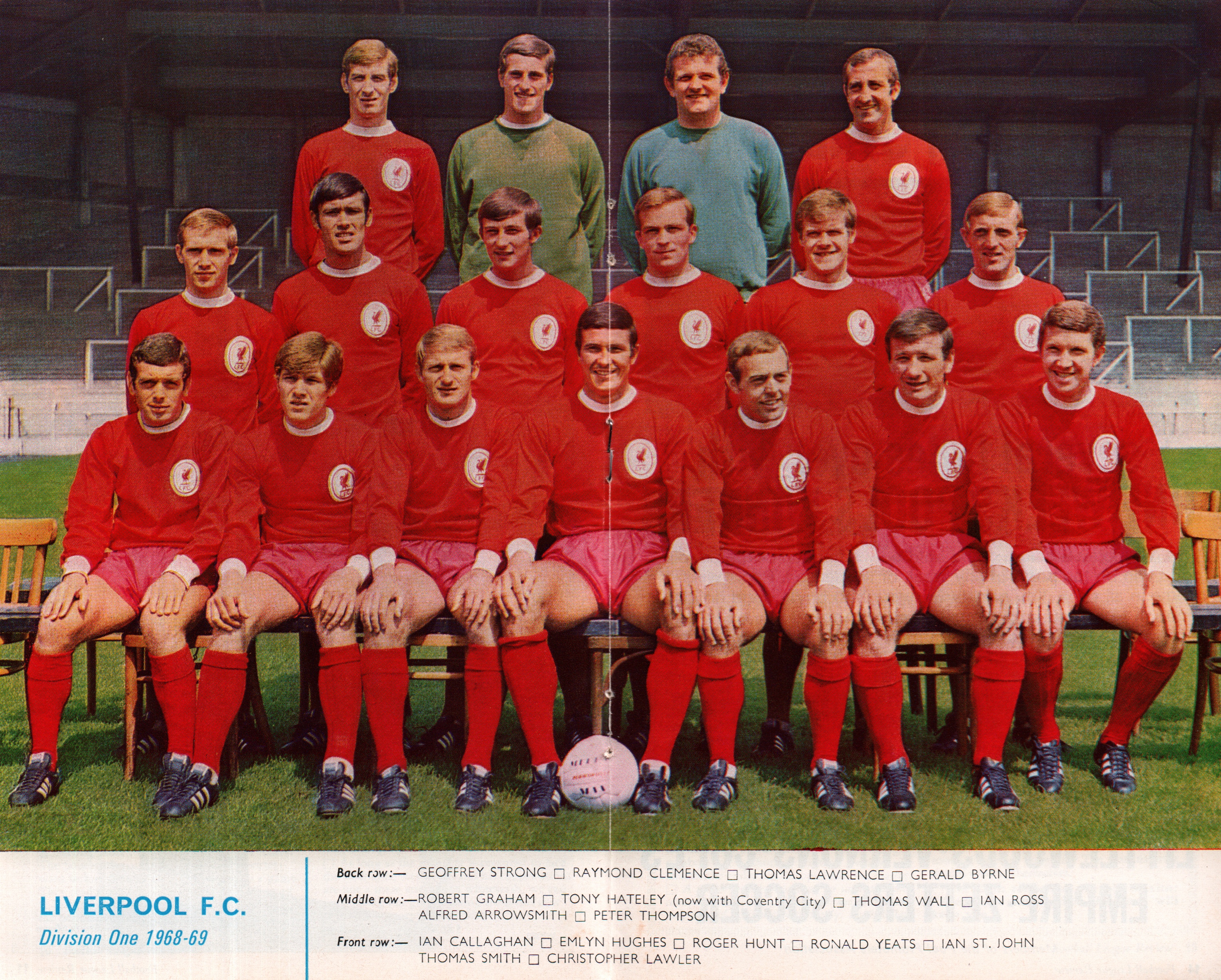 The centre pages of the FLR were given over to a team photo and I, like thousands of other kids round the country, carefully removed these pictures to plaster on my bedroom wall. This week in 1968 saw the Liverpool team featured. With not a sponsor’s logo in sight, the 68/69 Liverpool squad contained some familiar faces. Legends of the time such as Tommy Lawrence, Roger Hunt, Tommy Smith, Ian St John and Ron Yeats, were alongside promising young players like Raymond Clemence and Emlyn Hughes.
The centre pages of the FLR were given over to a team photo and I, like thousands of other kids round the country, carefully removed these pictures to plaster on my bedroom wall. This week in 1968 saw the Liverpool team featured. With not a sponsor’s logo in sight, the 68/69 Liverpool squad contained some familiar faces. Legends of the time such as Tommy Lawrence, Roger Hunt, Tommy Smith, Ian St John and Ron Yeats, were alongside promising young players like Raymond Clemence and Emlyn Hughes.
 Bryan Butler’s ‘Press Box’ column also looked at another aspect of the female influence on football. He writes about the importance of the footballer’s wife. Fifty years on, the ‘WAG’ culture has developed into something almost out of control at times, but in 1968, the lady behind the player was an important contributor to the success of his career.
Bryan Butler’s ‘Press Box’ column also looked at another aspect of the female influence on football. He writes about the importance of the footballer’s wife. Fifty years on, the ‘WAG’ culture has developed into something almost out of control at times, but in 1968, the lady behind the player was an important contributor to the success of his career.
We hear about a recent visit by Sheila McGowan of ‘Woman’ magazine, to the home of Bobby Charlton and his wife Norma, “pretty and dark-haired…a very striking looking girl”. Again, the casual sexism surfaces, with comments like “Friday night is no night for footballers to be nagged, worried or disturbed”, and “when I hear them shouting ‘Charlton you’re b***** useless’ I feel like turning round and thumping them with my handbag”. Bobby Charlton was one of the best footballers ever to play for England and in a classic illustration of how times were different fifty years ago, the article ends with the revealing fact that “Bobby smokes ten cigarettes a day – but never has his first until training is over at 2 o’clock” Incredible by today’s standards, but normal then.
 Tobacco advertising was everywhere and FLR was no exception. Full-page, colour adverts were carried for brands such as Woodbine – A good smoke, it’s good tobacco. You can’t lose with a Woodbine; and Park Drive – No flannel – All Flavour.
Tobacco advertising was everywhere and FLR was no exception. Full-page, colour adverts were carried for brands such as Woodbine – A good smoke, it’s good tobacco. You can’t lose with a Woodbine; and Park Drive – No flannel – All Flavour.
 In a final nod to the 1960s attitude to women, FLR publishes it’s Top Ten of good-looking footballers. There was some opposition, with the magazine postbag including letters from ladies who “feel that the basic reason for following a football team should be to appreciate the footballing skill”. For the record, it won’t surprise too many to discover that the man at the top of the charts was George Best. In the season so far, the Manchester United player was over 3,000 votes ahead of Liverpool’s Ian Callaghan.
In a final nod to the 1960s attitude to women, FLR publishes it’s Top Ten of good-looking footballers. There was some opposition, with the magazine postbag including letters from ladies who “feel that the basic reason for following a football team should be to appreciate the footballing skill”. For the record, it won’t surprise too many to discover that the man at the top of the charts was George Best. In the season so far, the Manchester United player was over 3,000 votes ahead of Liverpool’s Ian Callaghan.
 The ‘Ask the Ref’ feature at the back of the magazine contained readers’ queries on the Laws of the Game. The perennial issue of the offside law was to the fore, with J Haley from Odsal querying what happens if a shot rebounds off the crossbar and is put into the net by the player taking the shot. Not offside is the answer.
The ‘Ask the Ref’ feature at the back of the magazine contained readers’ queries on the Laws of the Game. The perennial issue of the offside law was to the fore, with J Haley from Odsal querying what happens if a shot rebounds off the crossbar and is put into the net by the player taking the shot. Not offside is the answer.
 Inside the back cover is a picture of Peter Shilton, Leicester City’s ‘brilliant young goalkeeper’. The 19-year-old had recently headed a ‘Tip for the Top’ poll in the magazine. They certainly got that right, as he went on to play 125 times for England!
Inside the back cover is a picture of Peter Shilton, Leicester City’s ‘brilliant young goalkeeper’. The 19-year-old had recently headed a ‘Tip for the Top’ poll in the magazine. They certainly got that right, as he went on to play 125 times for England!
The FLR was an invaluable source of knowledge for people like me, who couldn’t get enough football news and information. Being included in programmes was even better.
Glenn Murray: 99 not out. A look back at his career – is he our best ever striker?
As we go into this International break, Glenn Murray sits equal top of the post-war goalscoring charts for the Albion. His 99 goals is level with Kit Napier, who made 291 appearances between 1966 and 1972. Excluding war-time matches, when the rules on appearances were very different, only the legendary Tommy Cook is ahead of Napier and Murray. His 123 goals came between 1921 and 1929 and his story will be told in a separate post at another time.
So what of the enigmatic Glenn Murray? He turned 35 just a few weeks ago and is still banging in the goals in the Premier League, ten-and-a-half years since he made the move from Rochdale to the South Coast.

Form the Albion programme – 19 February 2008
In 2002, Murray was playing for non-league Workington Reds. He had two seasons with them, before moving to the brilliantly-named Wilmington Hammerheads, who played in the American Soccer League. After 14 games (and 3 goals), he returned to Cumbria (well you would, wouldn’t you?) and Barrow, where he scored 6 in 6 games. This led to a move to Carlisle United, who were then in the Conference.
At Brunton Park, he began to hone his skills and was part of the side that gained promotion to the football league, via the play-offs, in 2005. The following year, Carlisle achieved back-to-back promotions, winning League Two. Glenn wasn’t the main man at Carlisle, making just 46 appearances in those two seasons.
At the start of the 2006/07 season, he went on loan to Stockport County, returning after two months, with 11 appearances and 3 goals. He then moved to Rochdale, first on loan, then permanently from January 2007. In the next 12 months, he played 54 times, scoring 25 goals. It was at that time, that other clubs began taking notice of the quietly-spoken man from Cumbria.
Albion scouts started tracking Murray in December 2006 and Barry Lloyd and his team watched him on a regular basis. Rochdale were playing well and he was banging in the goals. Dick Knight opened negotiations with his counterparts at Spotland and after weeks of talks, we paid £300,000 for his services.
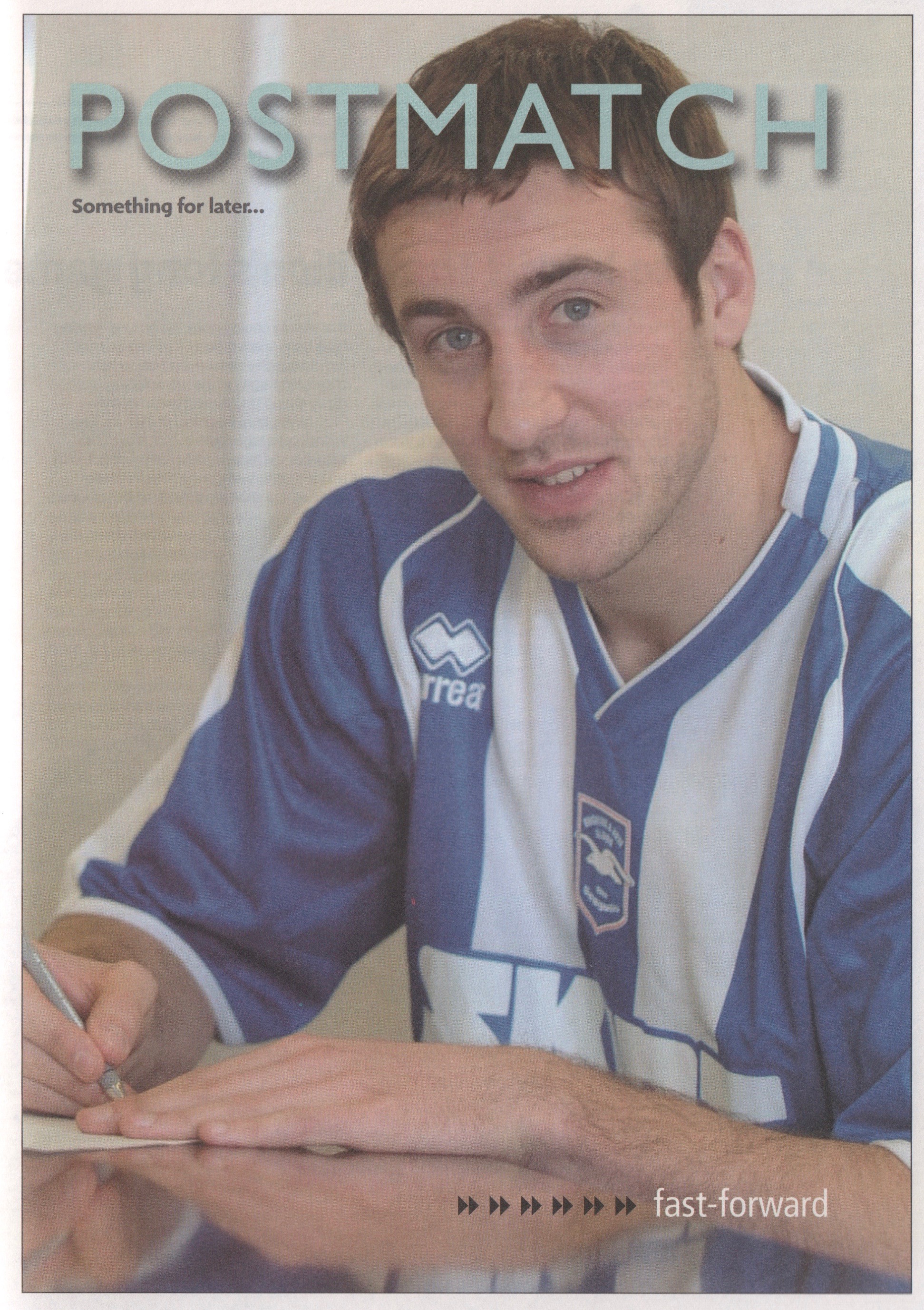
Contract signed – January 2008
That season ended with Murray scoring nine times. The 2008/09 season continued in the same vein and he netted 12 goals, including one in the famous victory against Manchester City in the League Cup. That season was a struggle for Albion and we survived on the last day, thanks to a Nicky Forster goal against Stockport County.
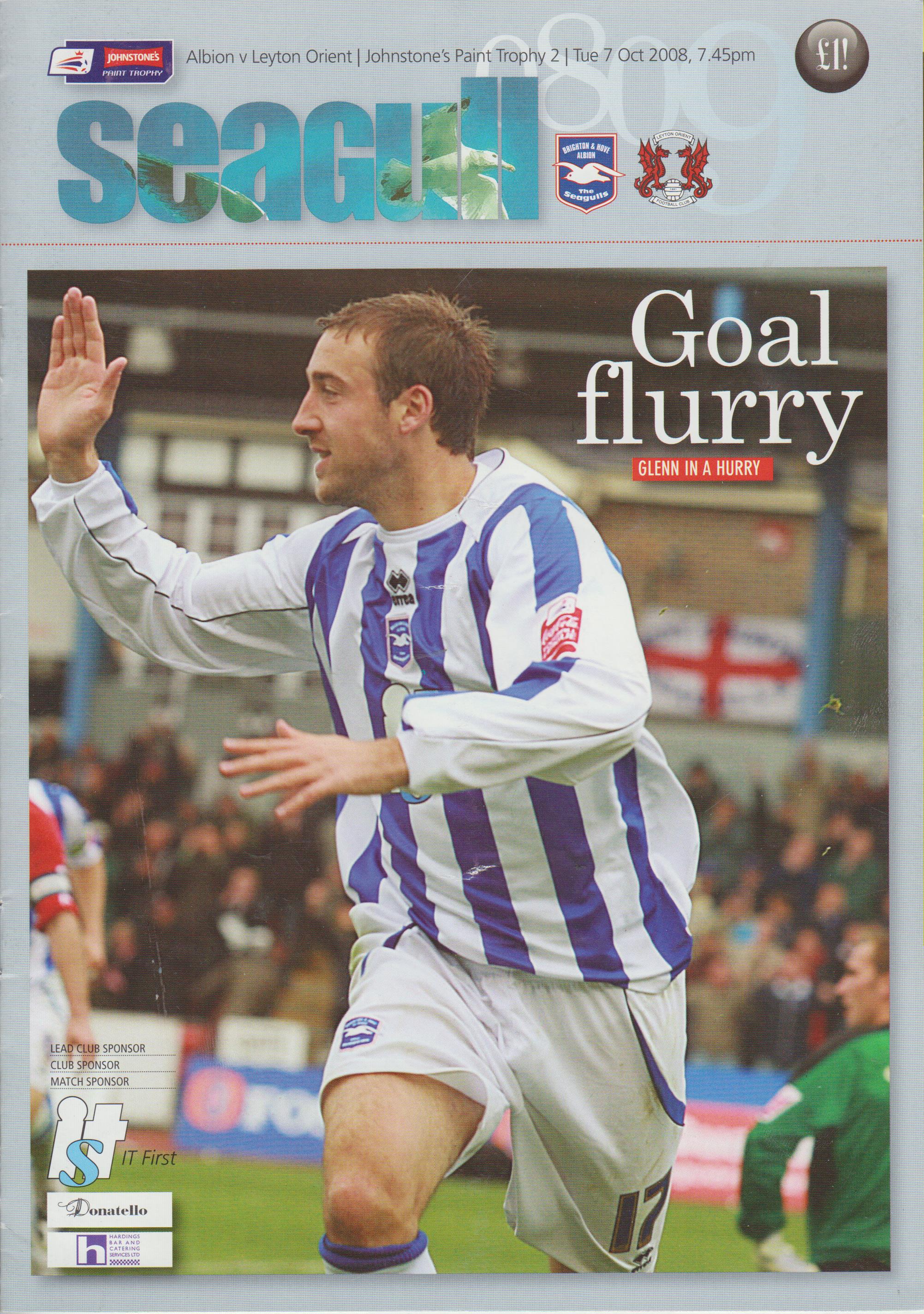 The following season saw Russell Slade sacked and he was replaced by Gus Poyet. His first league game in charge was away at St Marys against Southampton. Murray was brilliant that day, scoring twice as Albion dealt out a football lesson in front of the travelling Albion fans. I live in Southampton and the win gave my children bragging rights at school for a while afterwards, so thank you Glenn Murray!
The following season saw Russell Slade sacked and he was replaced by Gus Poyet. His first league game in charge was away at St Marys against Southampton. Murray was brilliant that day, scoring twice as Albion dealt out a football lesson in front of the travelling Albion fans. I live in Southampton and the win gave my children bragging rights at school for a while afterwards, so thank you Glenn Murray!
Murray again improved his goal tally for the season, with 14. This included 6 goals against Wycombe Wanderers. He notched 4 in the away (league) game, to go with the 2 in the FA Cup game earlier in the season.
By the start of 2010/11, Gus Poyet had refined his squad and hopes were high for a successful season. It was to become one of the most exhilarating periods any Albion fan can remember. We hit the top of League One table at the end of October and stayed there for the rest of the season, despite Southampton’s efforts to catch up. 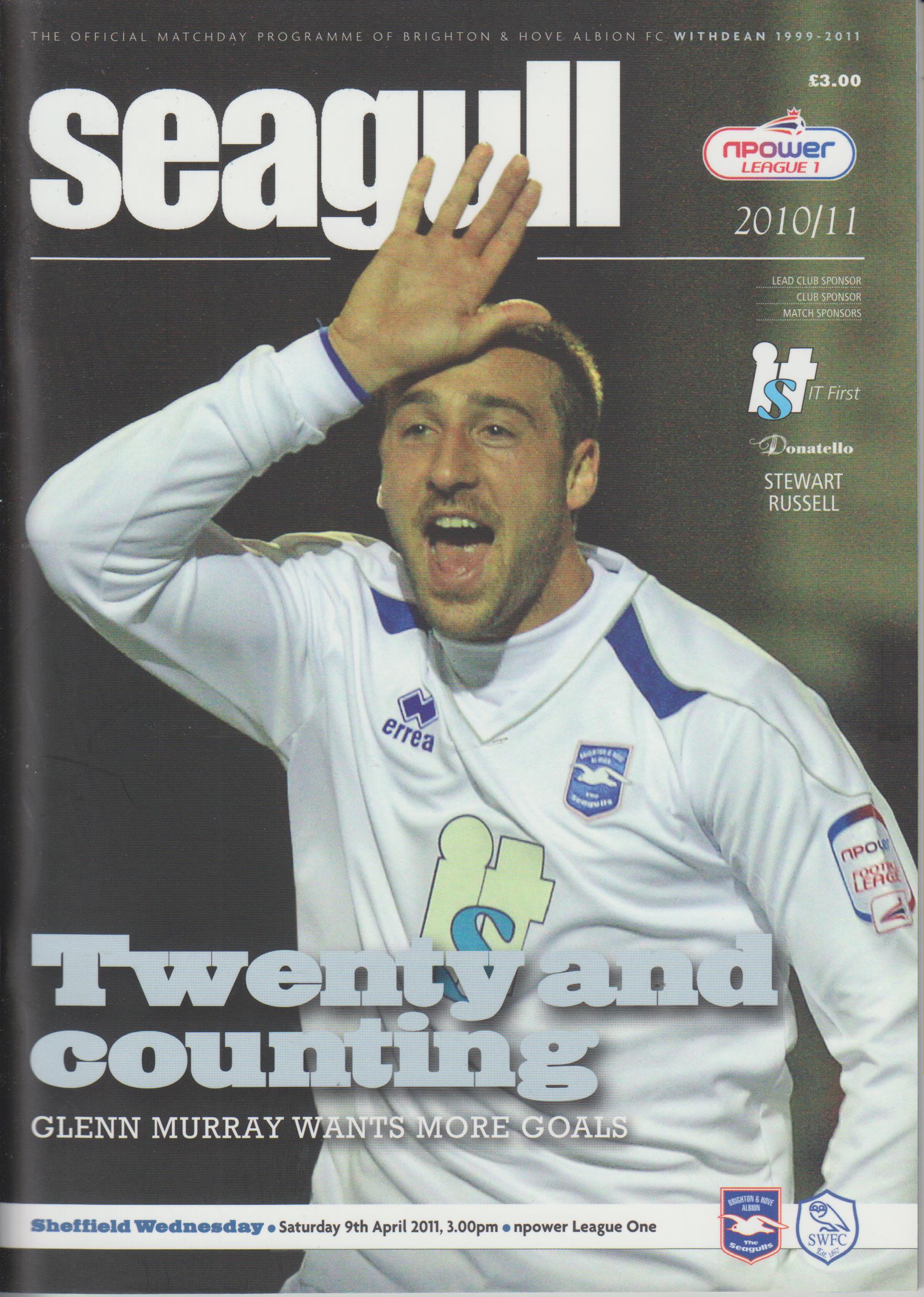 Glenn Murray was unbelievable, scoring 22 league goals as we swept all before us. In a dream scenario, his goals had taken us not only to promotion, but into our new stadium at Falmer as a Championship club.
Glenn Murray was unbelievable, scoring 22 league goals as we swept all before us. In a dream scenario, his goals had taken us not only to promotion, but into our new stadium at Falmer as a Championship club.
Then came the bombshell. He was leaving the club. Much has been written about the circumstances and I guess we will never know the true story until the main players write their autobiographies. Murray’s playing style was best described as ‘laconic’ but many people interpreted this as ‘lazy’. Twenty-two goals tells a slightly different story but whatever went on behind closed doors, the upshot was that he left and we brought in Craig Mackail-Smith. He certainly wasn’t lazy, but he also wasn’t a goalscorer.
Matters were made worse when Glenn Murray signed for Crystal Palace. He kept his house in Brighton but every goal he scored that season was a dagger in the heart of Albion fans. Debate was raging as to the reasons for his departure, with fans split between the ‘good riddance, he’s too slow’ camp and those that felt he would have carried on from where he left off in 2010/11. The fact that he didn’t celebrate his goal for Palace against us at the end of September was small consolation, but it did maybe give us an inkling that a part of his heart remained in Brighton.
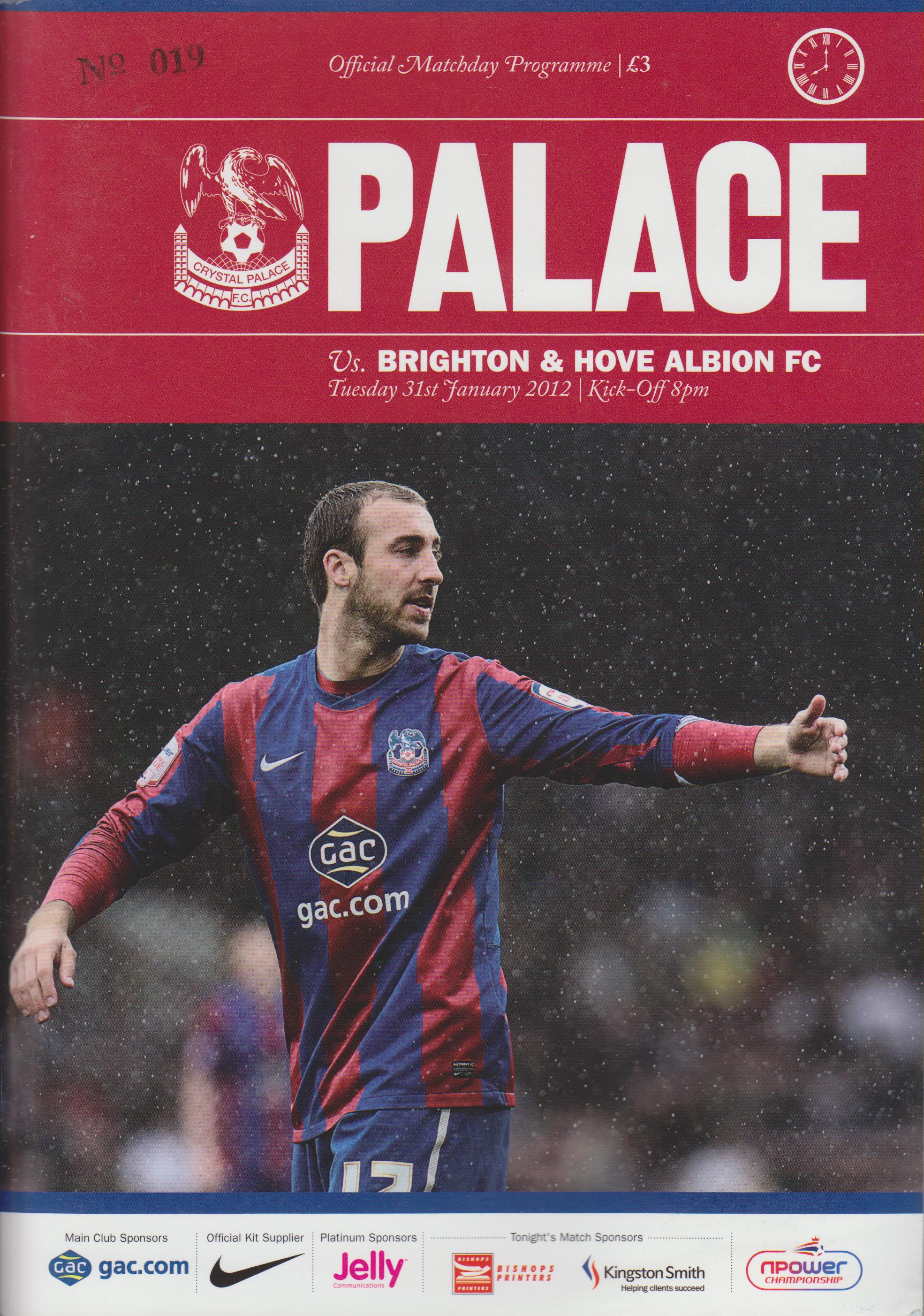
With the enemy
At the start of 2014/15, he joined Reading until January 2015, with a view to a permanent move. This didn’t materialise and he returned to Palace at the end of the loan spell. His time at Reading included another game in which he scored AGAINST Albion, in a 2-2 draw at Falmer in December 2014.
He played twice at the start of 2015/16 before a permanent move, this time to Bournemouth. The fee was £4million and his 22 appearances that season brought him 4 goals. That same season brought heartbreak for Albion, missing out on promotion to The Premier League by the narrowest of margins. Tomer Hemed was top-scorer with 17 goals but the rest were spread across the team. This was no bad thing, but it was felt we needed something extra up front if we were to get over the line.
When rumours of Glenn Murray’s return started to surface, social media went into complete meltdown. Many felt it would be a backward step and there was a sizeable number of fans who felt he couldn’t return because he ‘had played for that lot up the road’. Luckily, Tony Bloom and Chris Hughton ignored the more hysterical shouts of outrage and on 3rd July 2016, Glenn returned to Brighton after 5-and-a-half years. He hadn’t really been away, of course. His house was still in Withdean and many fans were quick to tell tales of bumping into him at various shops and petrol stations around Brighton.
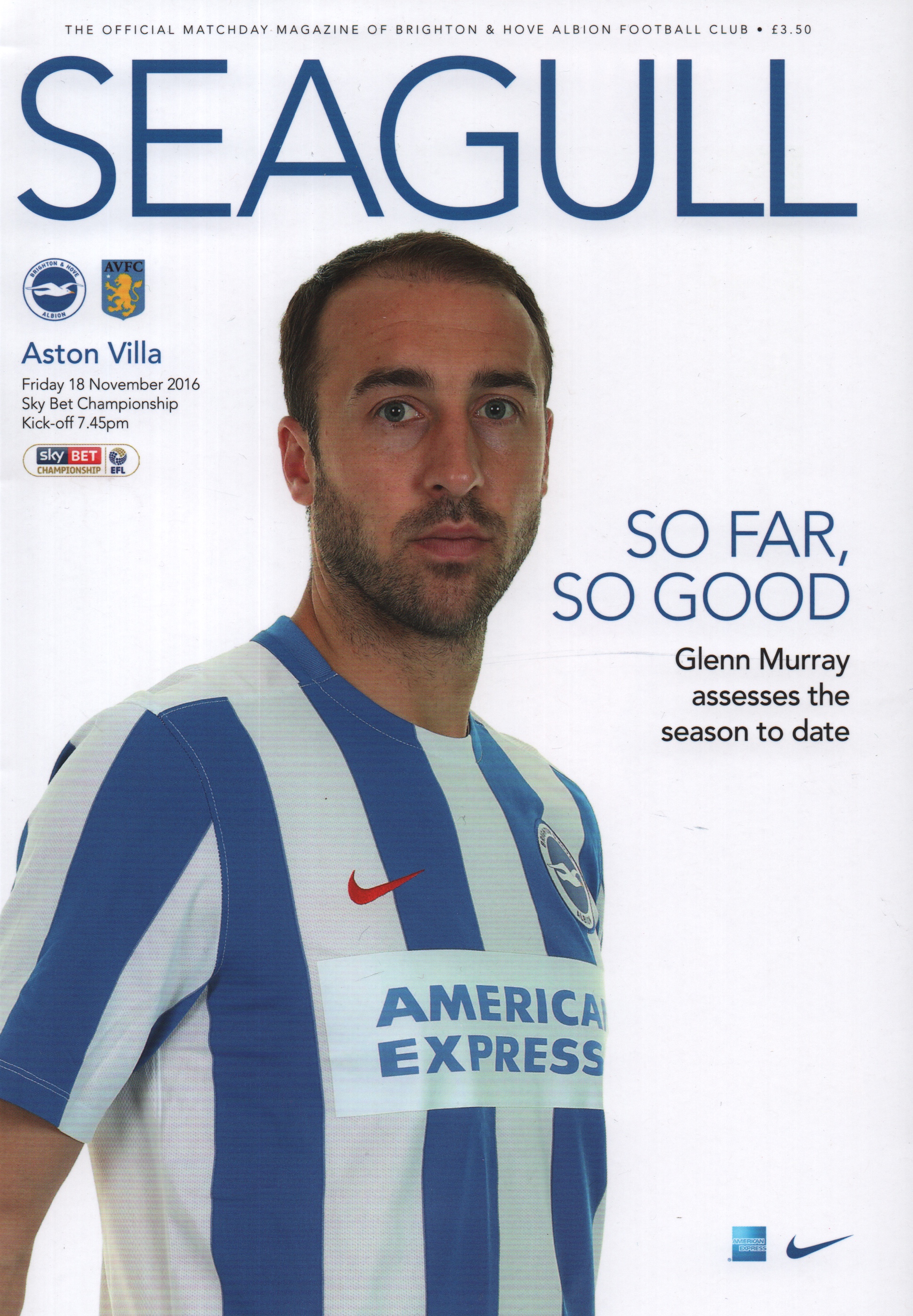 The one thing guaranteed to quieten the most vociferous critics is goals, and Murray hit the ground running. Three came in the first two games and by Christmas, he already had 15. Any doubts about his fitness were firmly put to bed when, after scoring a 95th-minute winner at Birmingham City just before Christmas, he sprinted the length of the pitch to celebrate in front of the 1,207 delirious Albion away fans. Eight more came by the end of the season, including the opener against Wigan in April, the game that indirectly clinched promotion. Glenn Murray’s critics had been well and truly shut down but as we entered the promised land of milk and honey (and TV money), the doubts over his ability to perform again began to surface.
The one thing guaranteed to quieten the most vociferous critics is goals, and Murray hit the ground running. Three came in the first two games and by Christmas, he already had 15. Any doubts about his fitness were firmly put to bed when, after scoring a 95th-minute winner at Birmingham City just before Christmas, he sprinted the length of the pitch to celebrate in front of the 1,207 delirious Albion away fans. Eight more came by the end of the season, including the opener against Wigan in April, the game that indirectly clinched promotion. Glenn Murray’s critics had been well and truly shut down but as we entered the promised land of milk and honey (and TV money), the doubts over his ability to perform again began to surface.
He started slowly as Albion found their feet under the top table but a brace at West Ham in October set him on the way. He even found time to score twice against Palace, one of those being the winner in the FA Cup 3rd Round tie at The Amex. Fourteen goals in all competitions took his Albion tally to 94, just one behind Peter Ward and four ahead of Bobby Zamora. Wardy was the ultimate Albion hero and for many people of a certain age (me included), the person who could never be toppled as their favourite Albion player.
Peter Ward was unbelievable as we rose through the divisions in the late 1970s. Like Murray, his Albion goals came across three divisions and in two spells for the club. Murray though, left for Crystal Palace and while players have a completely different emotional attachment to the club than the fans, for him to come back and win us over all over again, was an incredible achievement.
Zamora too was a superb player for us, scoring 90 goals across his time at the club. When he returned, while it undoubtedly gave the club a huge lift, he didn’t quite re-capture the clinical form he had showed in the early-2000s.
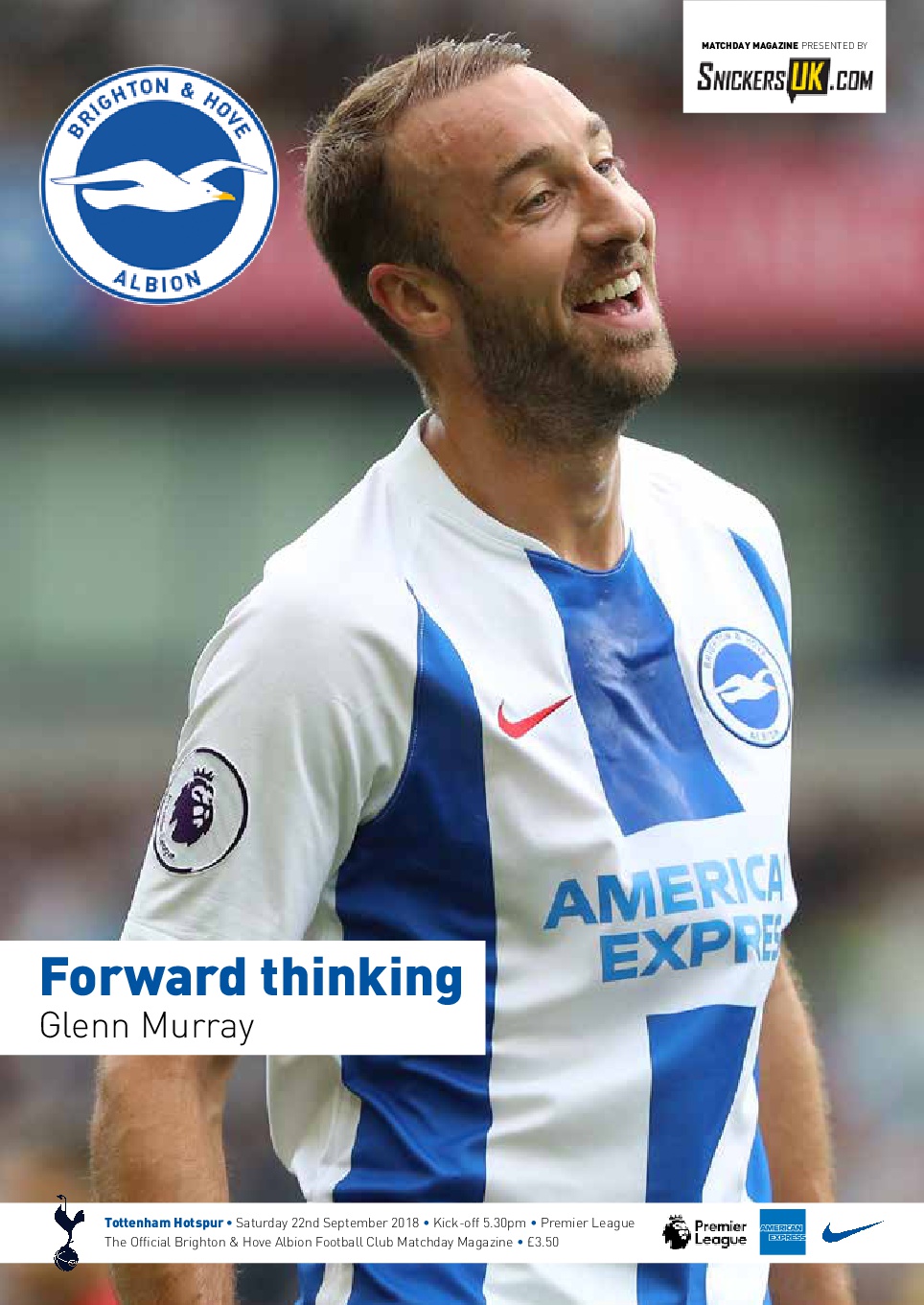 At the start of this season, thoughts turned to whether Glenn Murray could reach 100 Albion goals and overhaul Kit Napier. All Napier’s goals had come in the third tier and although a fantastic achievement, was not at the same level as Glenn Murray.
At the start of this season, thoughts turned to whether Glenn Murray could reach 100 Albion goals and overhaul Kit Napier. All Napier’s goals had come in the third tier and although a fantastic achievement, was not at the same level as Glenn Murray.
After five goals in eight Premier League games so far this campaign, Murray stands on the threshold of true Albion greatness. It seems likely that the next two or three games will see him reach that century and who knows, he may even challenge Tommy Cook’s all-time (Peacetime) record of 123. Even if he doesn’t score another goal for us he will surely go down as our greatest ever striker.
Glenn Murray, we salute you.
Fifty Years, Fifty Programmes – 1972/73
The early 1970s.
What a time to be alive, or to be more specific, what a time to be entering your teenage years. It’s that period in your life when a whole new world is opened up and you realise there is more to life than home, school and crap TV.
For me, I already had Brighton & Hove Albion to distract me, but as I reached my 13th birthday, the twin spectres of music and girls made an entrance.
In September 1972 I moved into the third year (Year 9 in today’s language) at Bognor Regis Comprehensive. This involved moving across the playing field into the school that housed all years up to the Upper 6th Form. From looking at pre-pubescent girls all day, I was transported into a world that brought me in to contact (from a distance at any rate) with actual real women, albeit the seventeen year old version. It was an eye-opener in many ways and got my hormones racing. This led to a few tragic and short-term fumbles with various girls who will remain anonymous to protect them (and me, obviously).
My Dad had passed on his old record player to me. It was a cream-coloured machine with a funny gizmo attached to the spindle that, in theory, allowed me to pile a few 7-inch singles on top of one another to avoid having to get up each time the track finished. This never really worked properly but despite this, the record player was my absolute pride and joy.
 The first single I bought was ‘You Wear it Well’ by Rod Stewart and it is one of my great life achievements that I still have this record. Another hugely popular artist at the time was a young singer called Gary Glitter. He seemed to be on Top of the Pops every week, with songs like ‘Rock & Roll Part 1’ and, imaginatively, ‘Rock & Roll Part 2’. The story of his later life explains why he spent so much time in the TOTP studios but at the time, he was at the cutting edge of the Glam Rock movement.
The first single I bought was ‘You Wear it Well’ by Rod Stewart and it is one of my great life achievements that I still have this record. Another hugely popular artist at the time was a young singer called Gary Glitter. He seemed to be on Top of the Pops every week, with songs like ‘Rock & Roll Part 1’ and, imaginatively, ‘Rock & Roll Part 2’. The story of his later life explains why he spent so much time in the TOTP studios but at the time, he was at the cutting edge of the Glam Rock movement.
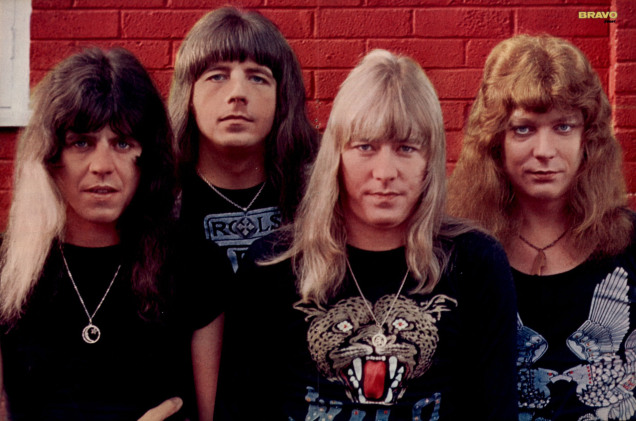 Other bands of the time included The Sweet and, of course, Slade. The latter band were to feature on the pitch at The Goldstone some years later. Slade were also part of the Glam Rock scene but their slightly harder edge led me to the discovery of a band that I still love to this day.
Other bands of the time included The Sweet and, of course, Slade. The latter band were to feature on the pitch at The Goldstone some years later. Slade were also part of the Glam Rock scene but their slightly harder edge led me to the discovery of a band that I still love to this day.

The actual album that I bought, all those years ago, framed at home.
My friends and I used to gather at each others houses with the latest records we had bought and one friend, Rob Howard, turned up one day with a copy of an album by The Who, called ‘Meaty Beaty, Big & Bouncy’. I found out later that this was a compilation of songs previously released as singles but I was so captivated by the sound, that I bought the album for myself, followed closely by ‘Who’s Next’, which had been released in November 1971. All these years later I still have the original copy of Meaty, Beaty Big & Bouncy.
Anyway, all these distractions meant that I had some decisions to make as to which aspect of my life was going to get the benefit of my pocket money. Girls didn’t really come into it, because a quick grope in the back row of Saturday morning pictures didn’t really cost too much. Records took most of the rest because I was still being taken to The Goldstone by my Dad, whenever he could.
In 1972/73 we were in the second division. Uncharted territory in my history with the club and only the fifth time ever that we had played at that level. Things didn’t go quite according to plan however, and between November 11th 1972 and January 27th 1973 we lost TWELVE league games in a row. Then, as now, second division clubs entered the FA Cup at the Third Round stage. We were in the middle of that horrendous losing run and I was hoping that we would get a completely rubbish team in the cup to try and get some confidence back.
No such luck.
 We were paired with First Division glamour-side Chelsea. They had England internationals John Hollins and Peter Osgood in their team, along with a host of other stars. I pleaded with my parents to be allowed to go to the game with my mates, the plan being that we would get into the North Stand and try to look like we had been standing there for years.
We were paired with First Division glamour-side Chelsea. They had England internationals John Hollins and Peter Osgood in their team, along with a host of other stars. I pleaded with my parents to be allowed to go to the game with my mates, the plan being that we would get into the North Stand and try to look like we had been standing there for years.
My parents relented, against their better judgement. Hooliganism was beginning to make a real impact on football in England and they were terrified the ‘You’re gonna get your fucking head kicked in’ chant was going to come horrifically true.
Pat Saward was still in charge and his programme notes for the game betray the worrying situation we found ourselves in. He welcomed the opportunity to play in the FA Cup,  but because “it gives us a chance to briefly forget about Albion’s unhappy plight at the foot of the Second Division table”. Mr Saward was, by nature, a positive man and he assured the fans that “we are trying our utmost to correct a slide that goes back to November”. He adopts the usual stance of the manager of a struggling team, by thanking the fans for their support, saying “I was delighted with the heart-warming applause you gave (the team) at half-time and the final whistle”.
but because “it gives us a chance to briefly forget about Albion’s unhappy plight at the foot of the Second Division table”. Mr Saward was, by nature, a positive man and he assured the fans that “we are trying our utmost to correct a slide that goes back to November”. He adopts the usual stance of the manager of a struggling team, by thanking the fans for their support, saying “I was delighted with the heart-warming applause you gave (the team) at half-time and the final whistle”.
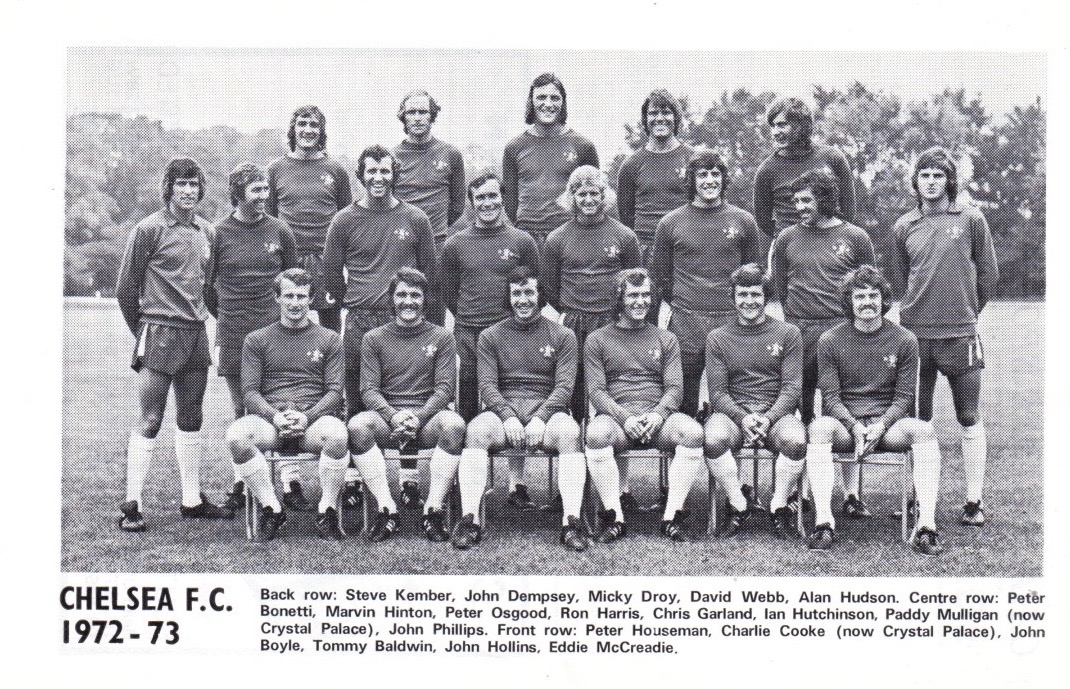 Chelsea were welcomed over three of the sixteen pages in the programme, and it reads like a Who’s Who of early-70s football flair. The team photo includes players like Peter Bonetti, Alan Hudson, Ron Harris, Ian Hutchinson and Eddie McCreadie, many of whom had played in the famous replayed FA Cup Final against Leeds United in 1970. Chelsea were managed by Dave Sexton, who had made 53 appearances for Albion in two seasons in the late 1950s.
Chelsea were welcomed over three of the sixteen pages in the programme, and it reads like a Who’s Who of early-70s football flair. The team photo includes players like Peter Bonetti, Alan Hudson, Ron Harris, Ian Hutchinson and Eddie McCreadie, many of whom had played in the famous replayed FA Cup Final against Leeds United in 1970. Chelsea were managed by Dave Sexton, who had made 53 appearances for Albion in two seasons in the late 1950s.
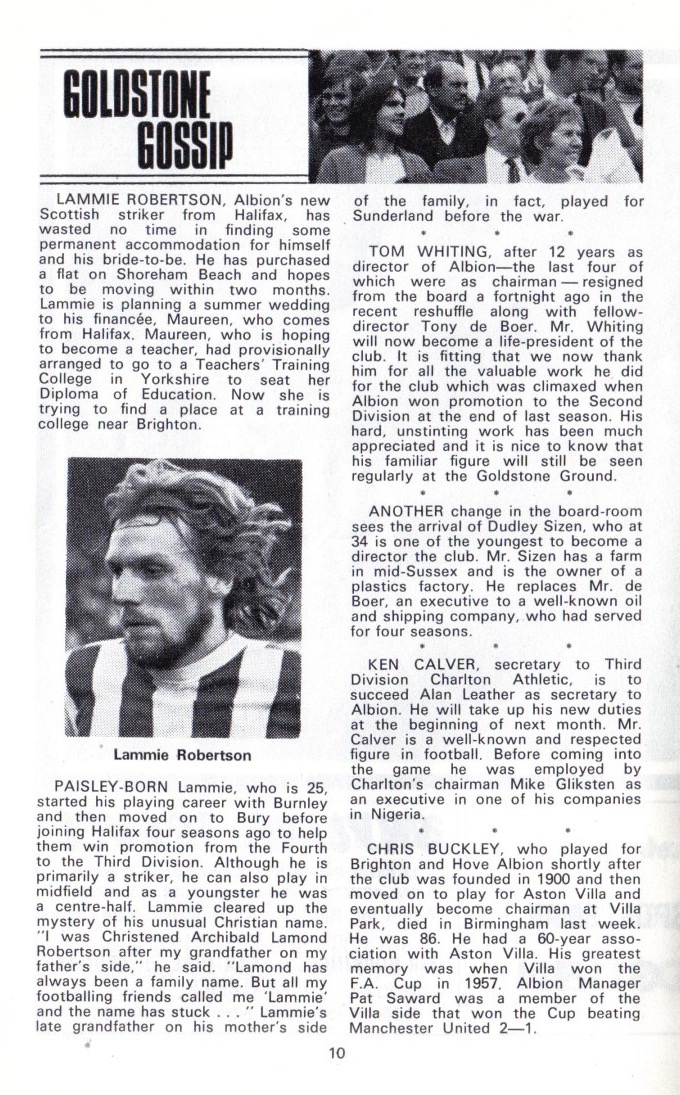 The ‘Goldstone Gossip’ article welcomed new signing Lammie Robertson to the club and informs us that he is looking to move in to a flat on Shoreham Beach with his bride-to-be Maureen, a trainee teacher. We are also told of a ‘boardroom shuffle’ that led to the resignation of -time Chairman Tom Whiting, as well as fellow board member Tony de Boer. One of the new board members was Dudley Sizen, who was to remain involved with Albion until 1996. The shuffle was brought about by a need for a financial re-structuring of the club and it led to Mike Bamber taking up the role of Chairman. He was bring about a golden era for Albion fans over the coming years.
The ‘Goldstone Gossip’ article welcomed new signing Lammie Robertson to the club and informs us that he is looking to move in to a flat on Shoreham Beach with his bride-to-be Maureen, a trainee teacher. We are also told of a ‘boardroom shuffle’ that led to the resignation of -time Chairman Tom Whiting, as well as fellow board member Tony de Boer. One of the new board members was Dudley Sizen, who was to remain involved with Albion until 1996. The shuffle was brought about by a need for a financial re-structuring of the club and it led to Mike Bamber taking up the role of Chairman. He was bring about a golden era for Albion fans over the coming years.
The game itself didn’t quite live up to the billing of a feast of flamboyant football. Bookings weren’t as frequent as they are now and you practically had to commit GBH before the referee got involved. He was a busy man as five men entered his notebook. In a particularly brutal sequence of the game, Albion’s George Ley and Chelsea’s Ron ‘Chopper’ Harris were sent off. The ‘Seagulls!’ book describes the final quarter of the game as ‘particularly brutal’. Chelsea won the game with two goals from Peter Osgood but the lively nature of the match was reflected off the pitch. While myself and my mates were able to steer clear of the trouble, 25 people were arrested for fighting on the terraces.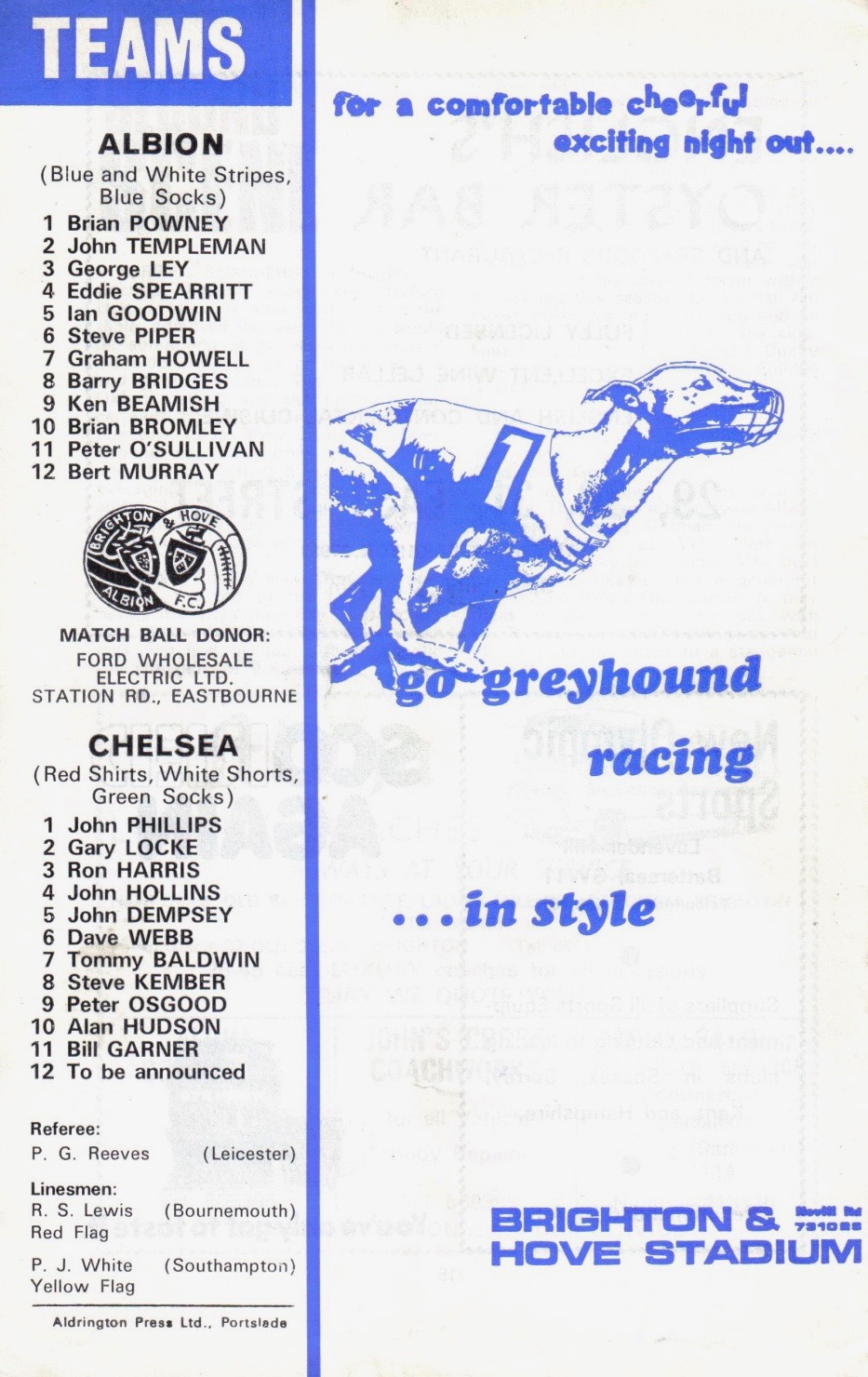
All in all it was an eventful day but unforgettable in the eyes of this 13-and-a-half year old boy. My parents were less enamoured by the days events and were VERY reluctant to let me go to games on my own. I pleaded with them, on the basis that ‘it’s easy to avoid the trouble’.
They eventually gave in and I saw a few more games as we continued our inevitable journey back to Division Three. The last game of the season was at home to Nottingham Forest and it was on that day, 28th April 1973, that my Albion-supporting time nearly came to an end.
I have said that it was easy to avoid trouble, but that isn’t quite the case when it was me causing it! I’m not talking about fighting, that really isn’t my thing. It was more to do with a bit of mindless (and pointless) vandalism. On the way back from the game, we were casually lobbing lightbulbs out of the train windows without too many cares in the World, when we were challenged by the train guard. Most of my friends just turned and ran away but I hesitated and ended up being locked in the guards metal cage.
I was handed over to the Police when we got back to Bognor and to say my parents were upset when I arrived home in a Police Car, was a massive understatement. They understandably went ballistic and among other things, I was banned from going to Brighton games for the foreseeable future. I ended up in Juvenile Court, was fined and had an altogether horrendous summer as I tried to worm my way back into my parents’ affections.
They eventually mellowed and I returned to action soon after the start of the 1973/74 season, back in Division Three.
If you’ve reached this far in my story, well done and thank you so much for persevering.
Until the next time.
References:
Seagulls! – The Story of Brighton & Hove Albion FC by Tim Carder and Roger Harris
Albion A-Z – A Who’s Who of Brighton & Hove Albion FC by the same authors
Albion – The First 100 Years by Paul Camillin and Stewart Weir
Rothmans Football Yearbook
The Football League Review
My children often ask me; “Dad, what was it like before the Internet?”. I tell them stories from a time long, long ago. Of encyclopaedias, libraries and strange things called newspapers. They look at me with wonder in their eyes.
Or is it pity?
Either way, we now have access to an almost unlimited amount of information, available at the click of a mouse, or the swipe of a screen. If you want to know the address of the Rochdale FC club shop, or the name of the ground where Bury FC play, that information would take less than 30 seconds to find.
I was born in 1959 and by the age of 7, was consumed by a thirst for knowledge of football. My Mum & Dad did their bit, by buying me magazines like Goal!, Charles Buchan’s Football Monthly and Shoot! but that wasn’t enough. I wanted facts, information and statistics – loads of them.
By that time, I had caught the football programme collecting bug, and couldn’t get enough of these wonderful little magazines. Whilst growing my collection, I stumbled across another little publication, one that went a long way to satisfying my endless quest for mindless trivia.

Soccer Review Issue 1 – 21 August 1965
I’m talking about The Football League Review.
A trail-blazing journalist in Leicester, by the name of Harry Brown, realised that the matchday programme for all 92 clubs in the Football League, presented a great opportunity to distribute his brainchild. On 21st August 1965, he launched Soccer Review, a magazine designed to be included within a club’s programme, covering news and views about football from all over the country.
England was in an absolute frenzy over the World Cup, which was less than 12 months away. Harry Brown was able to lock in to this feel-good vibe across the country and Soccer Review carried a lot of World Cup-related articles throughout the 1965/66 season.
By today’s standards (by any standards, to be honest) the quality of the magazine was pretty poor. Printed on rough paper, the columns were wonky, words disappeared off the edge of pages and the pictures (always black & white) were very grainy.
I wasn’t too bothered about the finer details of the production process. For me, it was all about information. That first issue contained articles about the newly-introduced concept of substitutes; the fact that showing emotion is actually good for players; a World Cup diary and an article written by Harry Brown’s daughter Marilyn, aged 15, about whether southern girls are slightly less enthusiastic about the game than their northern counterparts.
These were the days before the stifling constrictions of political correctness. If Harry Brown wanted to run a story on the best looking female supporters, then he did. Publish and be damned!

Football League Review, Vol 1, no 1 – August 1966
After that first, fairly experimental, season, Soccer Review became the Football League Review, a name retained for six seasons. At the start of the 1972/73 season, a further name-change saw the issue of ‘League Football’ magazine. This lasted until midway through the 1974/75 season, when rising costs and decreasing revenue saw circulation fall. The final copy came out in January 1975. The one good thing to come out of the demise of the magazine, was the realisation that programme editors needed to focus on the content of their own matchday issue, rather than rely on padding from a generic League publication. Coventry City, under the revolutionary stewardship of Jimmy Hill were the trailblazers in this regard. In the early 1970s, they experimented with bold colour schemes, radical page payouts, and a move towards content that was genuinely interesting for the readers, rather than a bland regurgitation of club information. As other clubs followed suit, the programme moved into the late 70s and 80s with renewed hope.
Soccer Review/Football League Review/League Football ran for 366 issues. 5,856 pages that left an indelible mark on my childhood.

League Football number 920. The final issue, January 1975
Over the next few weeks, I’m going to have a look back at these wonderful magazines and give an insight into league football in the decade from 1965 to 1975.
Thanks for reading.
As well as the magazines themselves, there are a couple of resources I would like to recommend if you want some more information.
The fantastic website Goals & Wickets has a superb ‘brief guide’ to the Football League Review, as well as a huge eBay shop with hundreds of Reviews for sale.
A sportswriter from Liverpool, Hyder Jawad, in the first issue of his ‘Soccerama’ series of books, wrote a magnificent history of the Football League Review, focusing on Harry brown and his increasingly fractious relationship with the Football League. For more information, have a look at the Soccerama FACEBOOK page.
Fifty Years, Fifty Programmes – 1971/72
At twelve years old, I was starting to really pester my parents to be able to go to The Goldstone on my own. It didn’t bother me that it was a couple of train journeys from Bognor and then a walk from Hove station. I just wanted to watch Albion every single week. My parents resisted, but they did agree to take me to as many games as they could.
Looking back at 1971/72, there are loads of candidates for the most important game of the season. We were promoted, so the Rochdale game right at the end of the season could go in there. We made an appearance on Match of the Day as well. In those days, it wasn’t all about the top flight. The BBC cameras visited three games a weekend across all four divisions and at the end of March 1972, our game against Aston Villa was chosen.
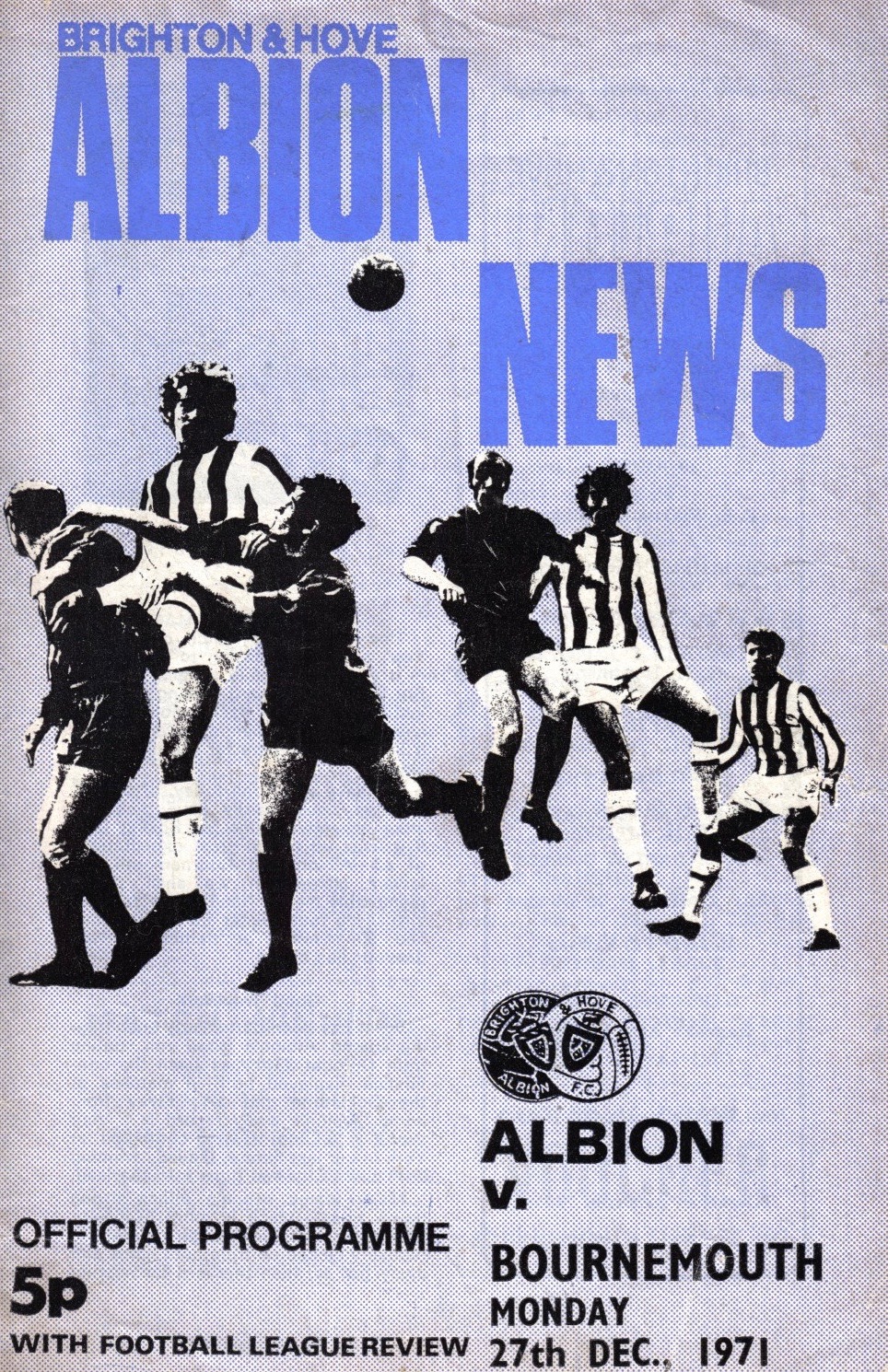 This series of articles is all about MY experience though, so I’m going for the game on 27th December 1971, when a huge Christmas crowd of 30,600, including me and Dad, turned up for the game against AFC Bournemouth.
This series of articles is all about MY experience though, so I’m going for the game on 27th December 1971, when a huge Christmas crowd of 30,600, including me and Dad, turned up for the game against AFC Bournemouth.
It was Christmas and my first experience of a ‘top-of-the-table clash’. Pat Saward was coming good on his promise of attacking football and we were just 4 points behind the Cherries, who were second.
Mr Saward’s programme notes were written, as always, in a very formal style. He welcomed Bournemouth for ‘what is virtually a four-pointer, and 90 minutes of tremendous endeavour lies ahead’. He also focuses on the consistency of the Albion team. Up to that point in the season, he had used just 16 players. Imagine that today! He also comments on the loyalty of some of the players. John Napier, Norman Gall, Dave Turner, Brian Powney and Kit Napier (no relation, strangely) had all played over 200 times for us and to me, these were some of the players who had helped form my love for Brighton & Hove Albion.
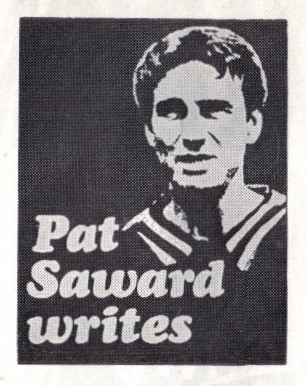
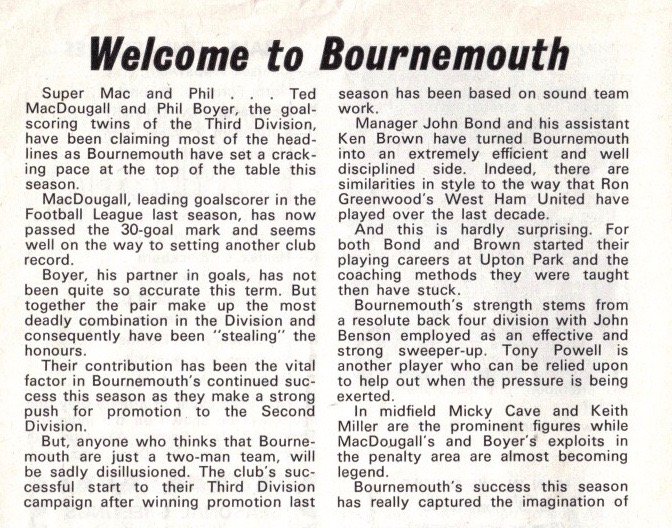 Mr Saward made no mention of the opposition that day, but Bournemouth were absolutely on fire. Up front, they had Ted MacDougall and Phil Boyer. Between them , they scored 50 goals that season with McDougall scoring NINE in an FA Cup game against Margate in November 1971. The ‘Welcome to Bournemouth’ section of the programme did talk at length about Boyer and ‘Super-Mac’, describing them as ‘the goal-scoring twins of the third division’.
Mr Saward made no mention of the opposition that day, but Bournemouth were absolutely on fire. Up front, they had Ted MacDougall and Phil Boyer. Between them , they scored 50 goals that season with McDougall scoring NINE in an FA Cup game against Margate in November 1971. The ‘Welcome to Bournemouth’ section of the programme did talk at length about Boyer and ‘Super-Mac’, describing them as ‘the goal-scoring twins of the third division’.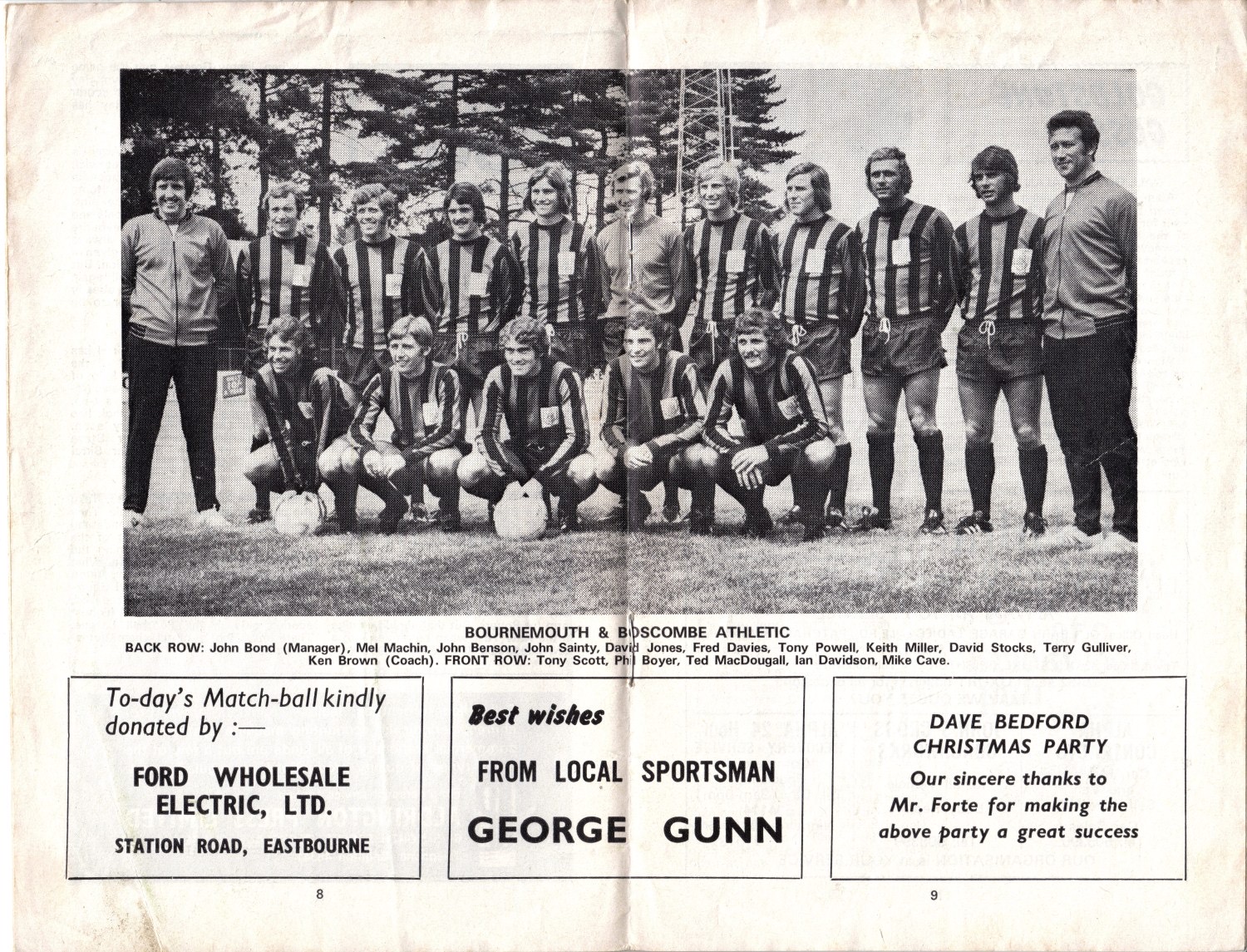
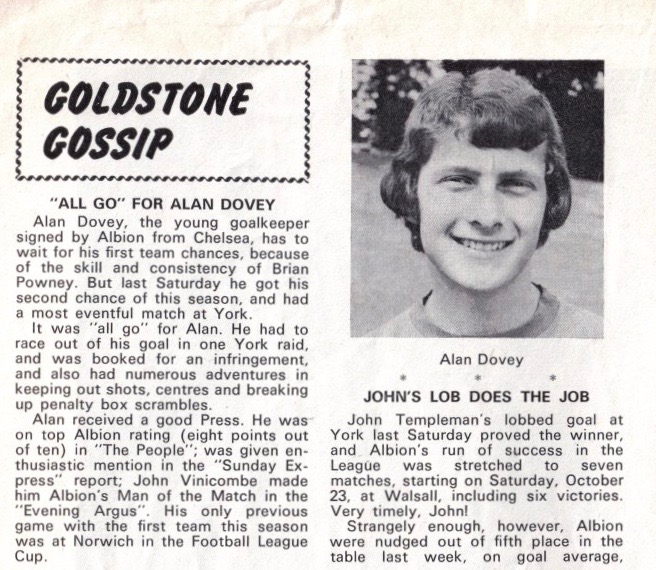 In ‘Goldstone Gossip’, young Albion goalkeeper Alan Dovey was praised for his great performance the previous week at York City. This was in the days of just one substitute and reserve goalkeepers had to wait for an injury or loss of form for their chance. Unfortunately for Dovey, Brian Powney was the model of consistency and skill. In his three seasons at The Goldstone, the young man only made 8 appearances. After leaving Albion he played locally, for Southwick and Worthing as well as a long spell with Peacehaven and Telscombe in the Sussex County League.
In ‘Goldstone Gossip’, young Albion goalkeeper Alan Dovey was praised for his great performance the previous week at York City. This was in the days of just one substitute and reserve goalkeepers had to wait for an injury or loss of form for their chance. Unfortunately for Dovey, Brian Powney was the model of consistency and skill. In his three seasons at The Goldstone, the young man only made 8 appearances. After leaving Albion he played locally, for Southwick and Worthing as well as a long spell with Peacehaven and Telscombe in the Sussex County League.
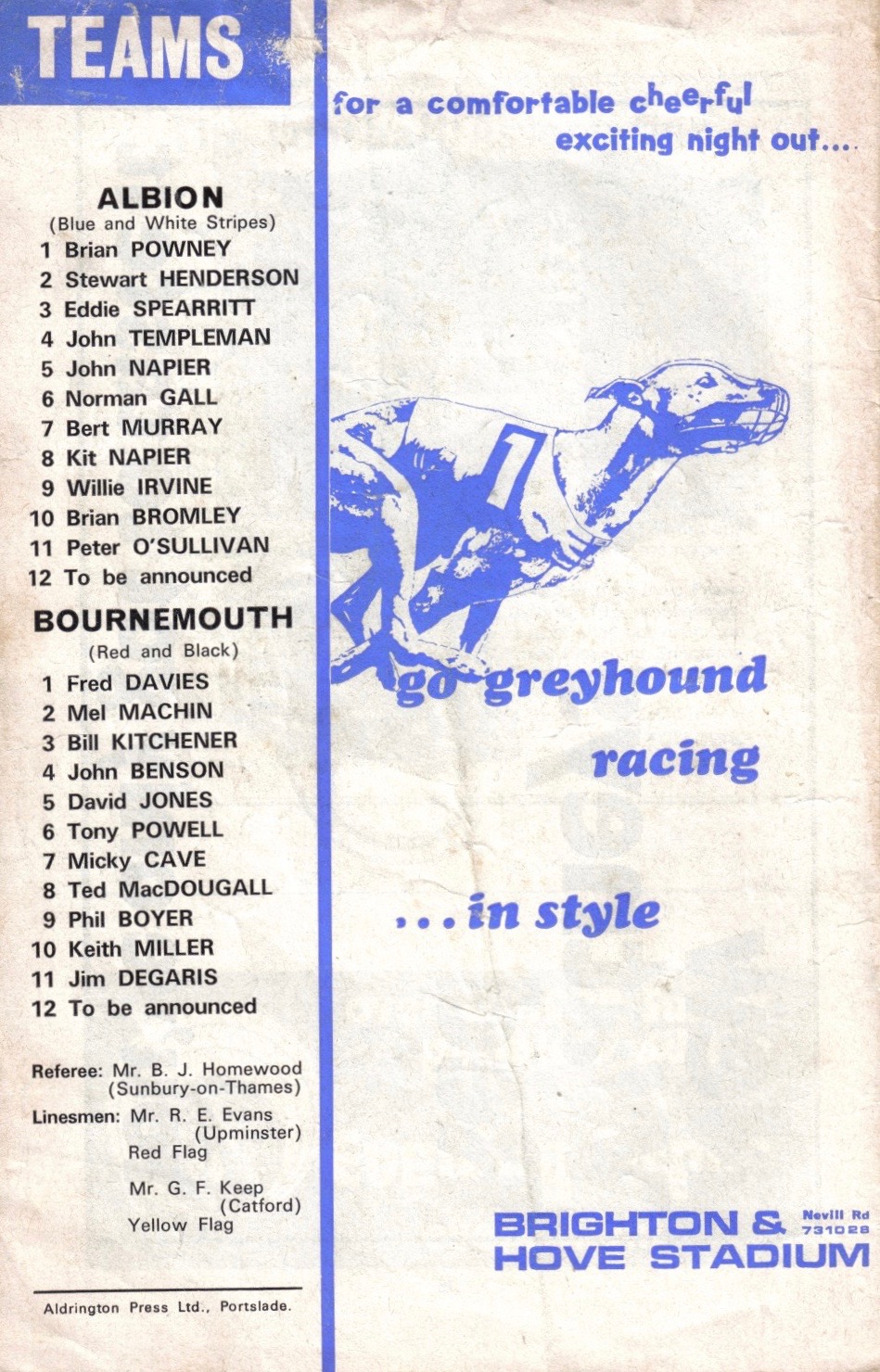 The game itself was fantastic in every way. We went 1-0 up with a goal from Kit Napier. I would love to say I remember this goal but I don’t. Which is a shame, because the various Albion history books describe it as ‘one of the best goals ever seen at the ground’. Kit Napier ended his Albion career on 99 goals, a total of peacetime goals only exceeded by Albion legend Tommy Cook. The goalscoring twins were kept very quiet by John Napier and Norman Gall and a second-half goal from Peter O’Sullivan sealed a great victory for Albion.
The game itself was fantastic in every way. We went 1-0 up with a goal from Kit Napier. I would love to say I remember this goal but I don’t. Which is a shame, because the various Albion history books describe it as ‘one of the best goals ever seen at the ground’. Kit Napier ended his Albion career on 99 goals, a total of peacetime goals only exceeded by Albion legend Tommy Cook. The goalscoring twins were kept very quiet by John Napier and Norman Gall and a second-half goal from Peter O’Sullivan sealed a great victory for Albion.
I was a very happy young man after the game and the season just got better and better after that. We only lost four games in the rest of the campaign and were promoted in second place, behind Aston Villa, with Bournemouth missing out. The game against Villa in March, as well as being in front of the cameras, featured another fantastic goal. This one I do remember. Partly because of the fact it came second in the Match of the Day ‘Goal of the Season’ competition, but also due to it now being available on YouTube. Willie Irvine scored it, but it was made by my first Albion hero, John Templeman.
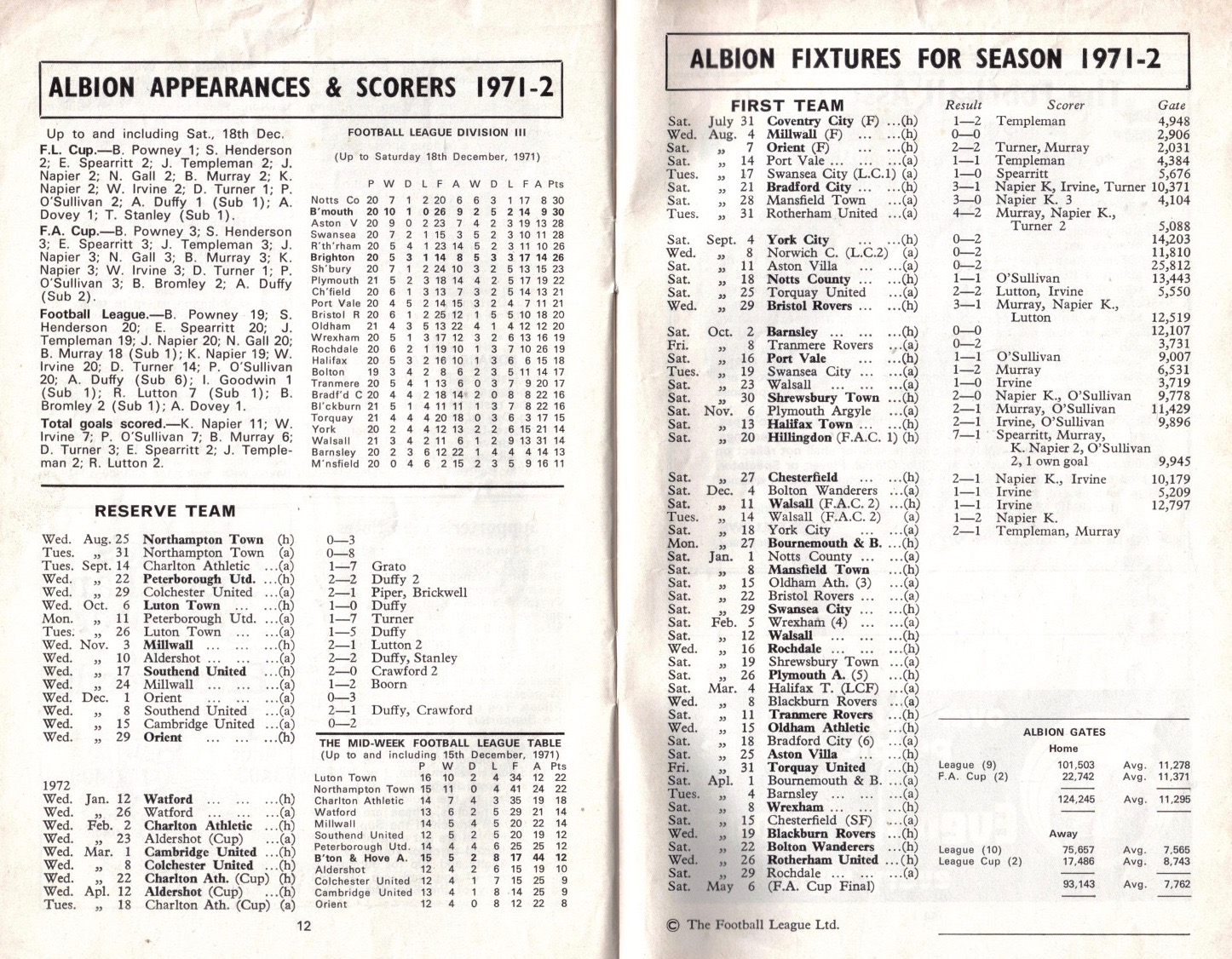 Promotion was clinched with a 1-1 draw against Rochdale, in front of another enormous crowd in the early May sunshine. The crowd of 34,766 was the fourth highest crowd ever at The Goldstone. Six crowds of over 25,000 were seen that season and as I moved towards my teenage years, my Albion life was looking in great shape.
Promotion was clinched with a 1-1 draw against Rochdale, in front of another enormous crowd in the early May sunshine. The crowd of 34,766 was the fourth highest crowd ever at The Goldstone. Six crowds of over 25,000 were seen that season and as I moved towards my teenage years, my Albion life was looking in great shape.
The following season saw my first taste of second division football, an FA Cup tie against Chelsea and, right at the end of the campaign, something that threatened to derail my obsession with football and The Albion. More of that soon.
As always, thanks for reading. It means a lot to me.
Thanks also to the reference books that provide me with all the statistics. All the programmes I write about can be viewed at my Seagulls Programmes website.
Reference:
Seagulls! – The Story of Brighton & Hove Albion FC by Tim Carder and Roger Harris
Albion A-Z – A Who’s Who of Brighton & Hove Albion FC by the same authors
Albion – The First 100 Years by Paul Camillin and Stewart Weir
Rothmans Football Yearbook

